






If your passengers are asking about the sustainability of your flight operations, let the PC-12 NGX be your answer.
PILATUS CENTRE SA
Authorised Sales Centre


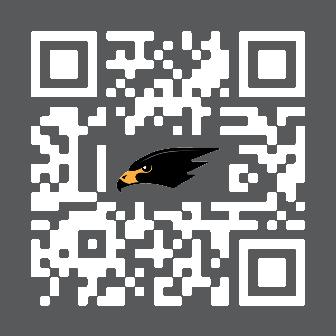

I AM COPPING FLAK for being sceptical of the Cape Winelands Airport (CWA) and its outgrowth to the operational management of Plettenburg Bay Airport.
I was challenged by the company that owns Cape Winelands Airport, rsa.AERO, to explain why I seem to have a problem with the airport’s redevelopment.
I support the airport because any airport is a good thing. However, offset against that, there are many riders.
The key rider is that airports are monopolies and as such, they are unsuitable for private sector ownership, unless there is rigorous regulation and price control, which is, of course anathema to the free market and private ownership.
weather at CWA, which I find hard to believe. Having lived in Cape Town for five years, my experience is that, if there is ground fog at Cape Town International, there is likely to be the same ground fog at CWA, notwithstanding research to the contrary. I have to wonder when the research was conducted if full runway visual range (RVR) measuring equipment was put in place for the whole year – and, given global warming, even whether one year is a useful sample?
And then of course there’s the time factorwhich seems to drag on indefinitely given the number of regulatory approvals that must be obtained.
The Cape Winelands Airport got off to a poor start due to its frontman, ‘billionaire’ Rob Hersov, making absurd claims. From what Hersov was saying, the airport seemed like an ill-conceived joke with his comments that there was going to be a drone school at the airport and also that it was going to be a Lanseria for Cape Town. Lanseria is much disparaged by the general aviation community for its unfriendliness towards general aviation, in favour of the far more profitable, and less hassle, of

Thereafter, rsa.AERO started making claims about the use of alternate airports and the
A further key question is whether Cape Town can support two hubs? Consider that the Cape has only a quarter of the hinterland (the north-east quadrant) that a centrally located airport has. If the Cape can only support a single hub, which airport will the regional airlines choose to feed and de-feed? Answer: the one the long-haul carriers are using.
Trying to turn both the old Fisantekraal Airport and now the Plettenburg Bay Airport into profitable entities capable of providing a Return on Capital for their investors will require huge user charges. As has been seen with Plettenberg Bay, the landing fees and hangar charges will have to dramatically increase to pay for the infrastructure and turn a profit.
So I have at best mixed feelings about the Cape Winelands project and their expansion into the Plettenberg Bay Airport.
j




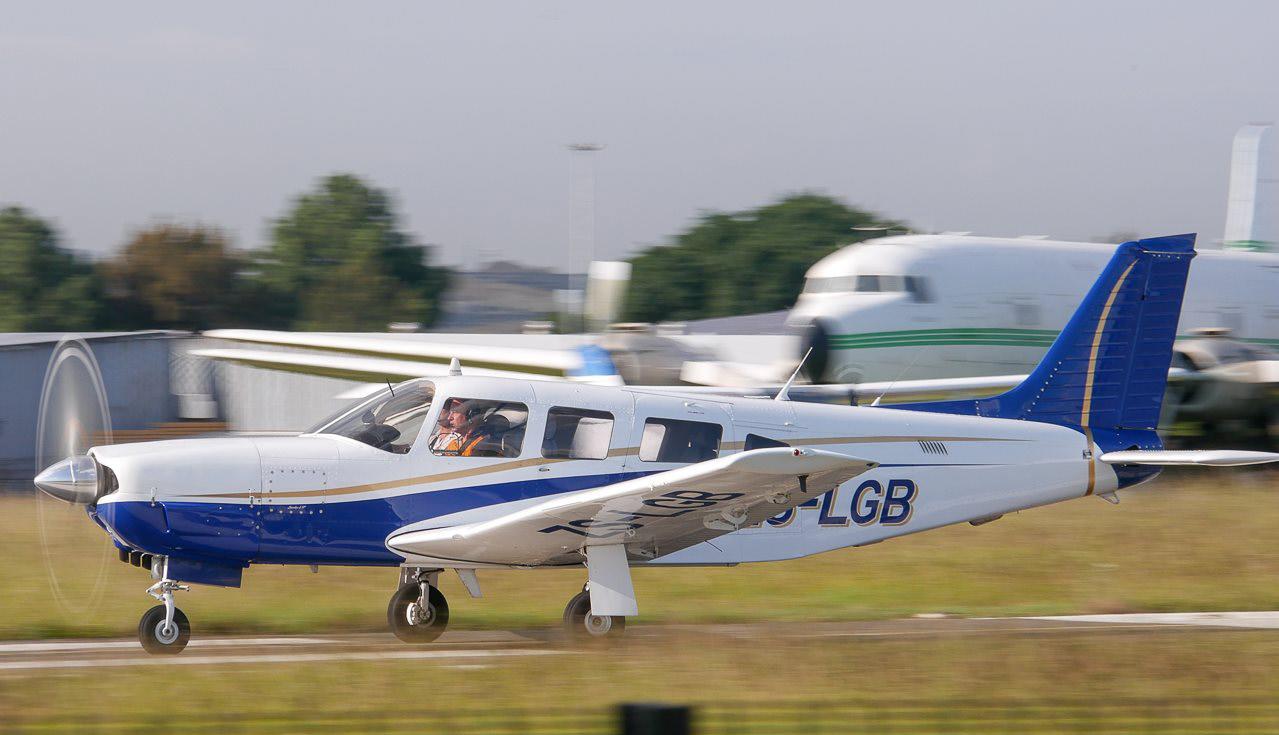


StandardAero Lanseria, a Pratt & Whitney PT6A designated overhaul facility (DOF) and the sole independent DOF approved for the PT6A-140, is pleased to support operators across Africa with P&W’s flat rate overhaul (FRO) program, which combines OEM-level quality with guaranteed “not to exceed” capped pricing. Meaning that you can plan your maintenance expenses with confidence, and without any compromises.
StandardAero Lanseria, a Pratt & Whitney PT6A designated overhaul facility (DOF) and the sole independent DOF approved for the PT6A-140, is pleased to support operators across Africa with P&W’s flat rate overhaul (FRO) program, which combines OEM-level quality with guaranteed “not to exceed” capped pricing. Meaning that you can plan your maintenance expenses with confidence, and without any compromises.
The FRO program does not incur extra charges for typical corrosion, sulphidation or repairable foreign object damage (FOD), and PMA parts are accepted.


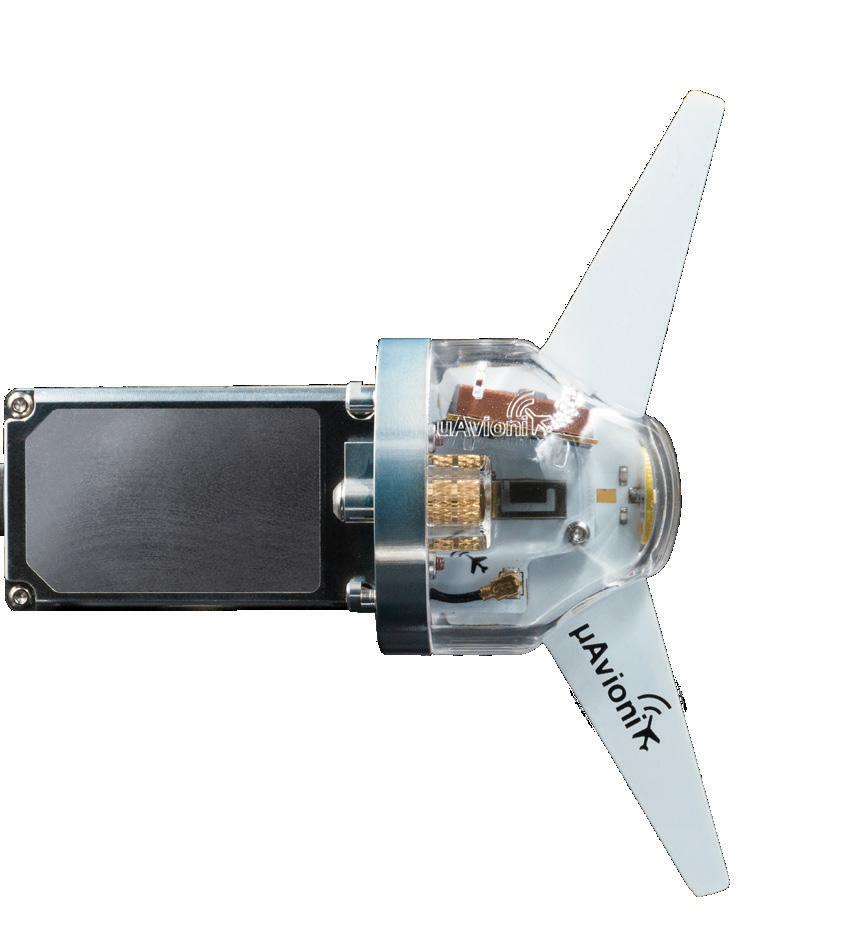
The FRO program does not incur extra charges for typical corrosion, sulphidation or repairable foreign object damage (FOD), and PMA parts are accepted.
As the industry’s leading independent aeroengine MRO provider, StandardAero is trusted by airline, governmental and business aviation operators worldwide for responsive, tailored support solutions. Contact us today to learn more.
As the industry’s leading independent aeroengine MRO provider, StandardAero is trusted by airline, governmental and business aviation operators worldwide for responsive, tailored support solutions. Contact us today to learn more.


AV-30 panel display. With seamless integration, advanced features, and reliability at your fingertips, the destinations are limitless. uAvionix—your key to opening the skies.




LOUIS GELDENHUYS
Pilots flying in the western Cape at this time of the year get to enjoy the incredible spectacle of the golden yellow Canola fields ripening in the sun.
This wonderful image of Louis Geldenhuys flying his trike was captured by Adriaan Burger using using his Samsung SM-S908E phone camera. Louis writes: “My love for flying began when I was just five-years old during my first flight in a trike. In 2013 I started flying microlights, and what began as a pastime quickly grew into a passion and that passion has now become my career. Today, I’m proud to be the owner of Cape Sky Adventures, at Wintervogel Airfield in Cape Town, where I get to live my dream every day.”


There are some subjects which create massively heated debate and then just go quiet. So, for a bit of excitement, I thought I would prod one of them back into life.
A PARTICULARLY INFLAMMATORY topic is airline pilots comparing their flight time to pilots who fly short charters, crop sprayers and helicopter pilots.
Airline pilots who have 20,000 hours may have logged thousands of hours while they are sleeping in the bunk. In stark contrast, charter pilots typically have to do all their flight planning, make command decisions and fly many sectors without a moment to relax. That is real flying, and intensely demanding. The same with crop sprayers and of course, helicopter pilots. The contrast with airline pilots snoring happily in a bunk could not be starker.
seats in business or first class are reserved for the pilots – which dents the airline’s prized business class revenue.
Even before reaching top of climb, the pilots who flew the takeoff will head to the bunks to sleep. In the cruise, sleeping is typically distributed evenly amongst the crew before all the pilots return to the flight deck about an hour before landing.
Most airlines operating ultra-long haul routes have to load four pilots to allow the pilots to sleep, (while still logging flight time). The standard procedure is that the same pairing of pilots will fly the takeoff and landing while the other pilots supervise the autopilot for the cruise. Most long-haul wide bodies have bunk beds available for both the pilots and cabin crew –but the fun police have made sure they are separate. If no bunks are available, passenger
A long haul (non-SAA) pilot provides more detail: “For example, on a flight of 14 hours, a crew of 4 will be allotted. The company will allocate a primary PIC (pilot in command) and FO (first officer), with a Cruise Captain and/or FO. There are a multitude of qualifications in terms of P2 (second pilots) who must be a regular First Officer. Experienced P2s may however be qualified to be Cruise Captain. To be an inflight relief first officer, a lowly ranked P3 pilot may not be at the controls below FL200.”
Once all the hierarchy has been sorted, the long-haul pilot explains, “The crew will generally divide the cruise into equal parts. Allowing time for takeoff and climb to cruise altitude,

establishment in the initial cruise altitude, (there will usually be step climbs later in the flight as fuel is burned off) and then allowing descent preparation, approach briefings etc, a cruise time segment is established. For the sake of simplicity, let’s say a 14 hour flight time is planned, allowing an hour to get from takeoff to cruise altitude, then an hour for descent preparation and the actual descent and landing; that leaves 12 hours.
‘The crew will then divide 12 hours by the 4 crew and allocate each member 2 x 3 hour rest segments. They will then decide amongst themselves who takes which rest segment when, based on factors such as who is already tired, what time zone their “body clock” might be in, and so on. After deciding this, each member will get 2 x 3 hour rest segments, allowing for the operating
crew to be at the controls for the takeoff to cruise altitude, then descent preparation and landing.”
It’s far better to have them alert
Not all pilots get to sleep in bunks – some can actually sleep behind the controls. This applies to short haul flights when there are only two pilots on board.
Controlled Rest In Position (CRIP) allows one pilot at a time to get up to 45 minutes of sleep in the cruise.
‘This is to promote a higher level of alertness during periods of high workload, for example the descent, approach and landing. The principle of controlled rest is to allow the pilots to boost alertness and energy. It’s the equivalent of a “power nap”.
Here is an example of permitted pilot CRIP sleeping: Two pilots are operating a night flight from Johannesburg to Dar es Salaam. They sign on at 20:00 on a Monday night. The flight is planned to leave at 21:00 with a block time (flight time and taxi time at both ends) of 04:30, giving a scheduled landing time of 01:30 in the wee small hours of the morning.
The turnaround time on the ground at Dar is 1 hour, meaning the return flight departs at 02:30. Again it’s a block time of 04:30 back, giving a scheduled landing time of 07:00. The pilots then go off duty at 07:30. This is if all the flights are running on schedule. Effectively they lose one night’s sleep and this will affect their performance.
Ideally controlled rest should be between around 10 – 20 minutes as this limits you to the lighter stages of nonrapid eye movement (NREM) sleep. Sleeping between 30 and 60 minutes can result in sleep inertia when you wake up, which will leave you feeling groggy, similar to a hangover.
• The resting pilot should ensure the operating pilot is adequately briefed to enable the other pilot to carry out their duties during the single-pilot operation.
There is of course always the risk that the nonresting pilot may also fall asleep, especially if she has no one to talk to. To reduce this risk, the cabin crew are told that controlled rest is taking place and regular contact is made between the operating pilot and the cabin crew.
There have been a number of high-profile incidents where both pilots have fallen fast asleep and missed their reporting or descent points. And so, increasingly airliners also have an alarm if none of the controls / switches / buttons have been touched for a while.
There are set rules that have to be followed when pilots take CRIP, such as:
• It must be agreed to by both pilots
• It should be limited to a predefined period between around 10 – 40 minutes.
• Only one pilot should take controlled rest at a time and that should be in his/her seat but with the seat pulled back, away from the controls.
• Once the resting pilot wakes, she should avoid operating the controls for a set period to ensure she is fully awake and alert. She should also be awake for at least 15 minutes before any high workload situations such as initiating the descent.
One of the most notorious examples of ‘sleeping pilots’ was Northwest Airlines 188. The crew insisted they “became immersed in a conversation about a new crew scheduling programme” and were studying their laptops. Nobody was listening to the radio or monitoring navigation and they overflew the destination by 100 miles. A flight attendant noticed that they should have landed by then and notified the pilots. They had been out of contact with air traffic control for almost two hours.
The FAA came down hard and stripped the pilots of all of their licences. They had to start over again as student pilots and re-gain private, instrument, multi-engine, commercial and ATP certificates from scratch. The captain retired early, and the first officer was offered retirement but declined and was dismissed from the airline.
This colossally embarrassing failure would probably have been avoided if the FAA approved ‘power naps’. South Africa, the U.S. Air Force, Australia, Canada, China, Europe, New Zealand and Turkey, allow crews to take a short catnap for up to 40 minutes.

Studies show that a short nap of just 15 minutes significantly improves the performance of a fatigued pilot. Qantas, Air Canada and Air France have specific procedures for CRIP and it is regularly practiced.
An airline captain writes, “Consumers are mostly against this procedure while about 75% of pilots favour it. I’m among those pilots. I’ve flown with first officers who have dropped off to sleep en-route and had trouble staying awake, even during descent and approach. Therefore, if a crewmember needs 15 minutes with their eyes closed, I don’t object. It’s far better to have them alert for the critical segments than alert during cruise.
“In my opinion, allowing reading in the cockpit gives the crew a diversion and actually sharpens them up for the descent and landing. Making the copilot stare out the window or at the unmoving dials does nothing but dull the senses until she’s in a stupor. Better to let the crew entertain themselves a bit while en-route and then have them feeling rested and ready for the approach.
“An interesting side note is that flight attendants are also prohibited from recreational reading in flight but they do it all the time. I don’t object to it at all.”




The first thing we do, let’s kill all the airspeed indicators.
THE AIRSPEED INDICATOR may be the oldest and most fundamental of the flight instruments, but it is also the one least suited to its job, which is primarily not to tell us how fast we are going, but rather to tell us where we are in the flight envelope. It is gratifying to know, as we cruise along, that we are indicating 137 knots; but the airspeed indicator is most important at low speeds, close to the stall, and it is there that it is most likely to play us false.
We use airspeed in two ways. As a gauge of dynamic pressure – that is, of the force exerted by moving air on the aeroplane – it tells us during the takeoff roll when to rotate. Dynamic pressure is also the defining parameter for gear and flap operating speeds, single-engine minimum control speed and neverexceed speed, although this last is actually a true airspeed, based on flutter considerations.
banked turn must pull 2 Gs to maintain altitude. Its Gweight is 6,000 pounds. If a one-G gust strikes it during the turn, its Gweight rises to 9,000 pounds.
It’s difficult for us to relate airspeed to the Gweight, because airspeed is proportional to Gweight’s square root. Suppose that our 3,000-pound aeroplane has a clean stalling speed of 70 kias; its best rate of climb speed is 100 kias and its manoeuvring speed is 125. At the end of a flight, with only the pilot and minimal fuel aboard, its Gweight is only 2,000 pounds; now it stalls at 57 kias and climbs at 82. Its manoeuvring speed is down to 100. In a 60-degree bank at gross weight, however, its stalling speed is 100; throw in that gust and it becomes 121.
Many of the characteristic speeds of an aeroplane, however – stalling, manoeuvring, turbulence penetration, glide, best rate or angle of climb – are proxies for certain angles of attack. As proxies, however, they are unreliable. They fail to factor in what I will temporarily call, without attempting to pronounce it aloud, the Gweight.
Gweight is the weight of the aeroplane multiplied by the G loading, and at any given moment it is equal to the lifting force being produced by the wing. A 3,000-pound aeroplane in a 60-degree
In other words, depending on circumstances, the stalling speed, that life-preserving number, can have almost any value.
Angle of attack, on the other hand, is for all practical purposes directly proportional to Gweight. All aeroplanes reach maximum lift at some angle of attack, usually 15 to 18 degrees above the zero-lift angle. They make half that lift at half that angle, a quarter at a quarter, and so on. The characteristic speeds of the aeroplane, since they correspond to certain angles of attack, also correspond to certain fractions of the maximum available lift.
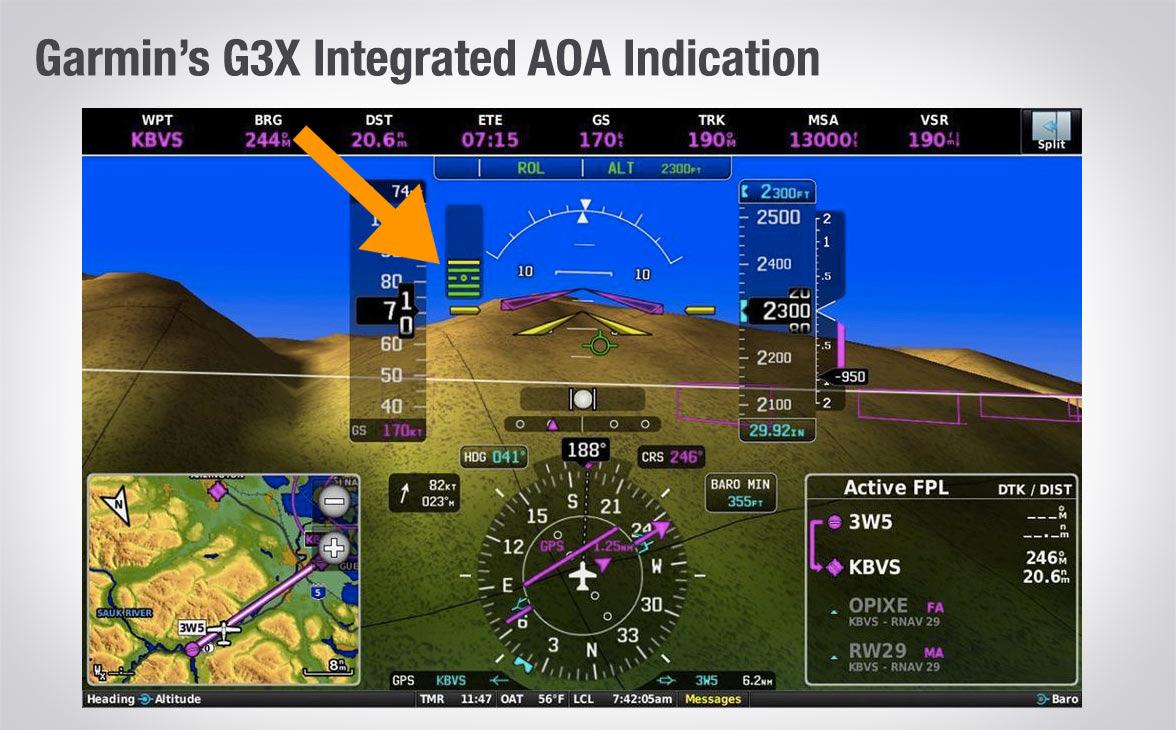
Suppose that instead of an airspeed indicator we have an instrument that displays percent of available wing lift on a scale of zero to 100, with 100 representing the maximum lift available, just before the stall. This lift gauge would be similar to an angle of attack indicator. but it would cover a wider range of angles of attack than usual. Angle of attack indicators tend to focus on the low-speed range; at high speeds, changes in angle of attack are small, hard to measure and of little practical importance. But I think angle of attack information would be useful at least up to the manoeuvring speed
Although I and my fellow aviation writers have been singing the praises of angle of attack indicators for ages – I have been flying with, and relying on, a Safe Flight SC-150 for 40 years – it was not until recently that a number of them appeared on the market. But they are still small, auxiliary-looking instruments, advertised as providing pilots with an extra margin of safety. That is putting the cart before the horse. A direct indication of the fraction of available lift being used ought to be primary for operations at airspeeds right up to the manoeuvring speed.
Unfortunately, a religious regard for the airspeed indicator is drilled into pilots from the very start of their training. We become conditioned – perhaps brainwashed would be a more appropriate word – to think of our flight state in terms of speed, not angle of attack or its equivalent, lift fraction. The presentation of angle of attack in an ancillary role merely reinforces that tendency.
The lift gauge, as I envision it, would be central and conspicuous. It would have markings at 50% (best rate of climb) and 60% (approach speed – 1.3 Vs) and an ominous-looking orange-grading-to-red band between 75 and 100. Since Gweight is proportional to angle of attack, what we now call “manoeuvring speed” would become, for a normal-category aeroplane, a mark at 26% (because the normal-category limit load factor, 3.8, times 26 equals 100). Whenever the moving index was between that mark and 100, you would have the protection provided by manoeuvring speed on the ASI. Below 26 would be the yellow arc.
Each type of aeroplane has its own characteristic speeds and its own set of airspeed indicator markings. The lift gauge, however,
would eliminate those differences. It would be exactly the same in all aeroplanes, regardless of speed range or wing loading, and would be used in the same way. It would automatically account for varying weights, G loadings and flap configurations. Unlike an airspeed indicator, it would be responsive to gusts: A positive gust would make the index jump upward, and if you saw the index repeatedly getting close to 100 you would know to lower the nose. This would represent an improvement over the current “ten knots for grandma” mantra for approaches in turbulence.
Airspeed indicators cannot be banished altogether. Let commerce flourish. The airspeed indicator supplies the dynamicpressure-related speeds, provides a backup in case of failure of the lift indicator, enables pilots to comply with ATC speed instructions, and in some cases is an aid to boasting.
with conveniently linear variation, by measuring either pressures or flow directions; that difficulty has always been an obstacle to simple, cheap AoA instrumentation.

Instead, some AoA-related variation in some parameter or other would be detected, and a microprocessor would be trained to translate it, for each aeroplane type, into fractions of available lift. This would then be conspicuously displayed, either on a gauge or as a portion of an electronic display, in such a way that it overshadows the airspeed indicator. In this case, size really does matter. A little brute force will be required to wean pilots from their airspeed indicators and to train them to rely on a lift gauge instead.
I leave the physical implementation of this device to someone more ingenious than I. It is unlikely that lift fraction could be sensed directly,
The sainted author of the foundational howto-fly book, Stick and Rudder, Wolfgang Langewiesche, always insisted that when we fly we are flying a wing. Wings don’t think about speed, they think about lift. We ought to start doing the same. j

— Herb Kelleher, Southwest Airlines.
“If the Wright brothers were alive today, Wilbur would have to fire Orville to reduce costs.”
BOOKS
by Peter Garrison





So if you know how to climb, and you know how to turn, then a climbing turn has to be pretty simple – yep? And if you can glide and turn, then is a gliding turn somehow special? Yes and no to both questions.
IF YOU ARE AN ORDINARY oke, then climbing and gliding turns are no big deal – unless you take them to extremes that ordinary okies don’t generally go to. But if you are a special sort of dude – like an aerobatic pilot, or a super special dude – like an instructor, then it’s time to prick up your super special ears.
Gliding Turns
Let’s look at gliding turns first. The easiest way to understand them is to think of a stairal spirecase. Have a look at the picture.
Now imagine you are an aeroplane – put one hand on each rail and start down the stairs. Can you see that the right wing – your right hand – goes down a steep slope, while your left wing goes down far less steeply?
This means that the inside wing will have a far bigger angle of


it often becomes the big deal

attack than the one on the outside of the turn. And of course, a bigger angle of attack gives you more lift.
So, in theory, this means two things:
The aircraft will tend to level its wings in a gliding turn.
The inside wing is going to stall first if you overcook a gliding turn, with the ball in the middle.
In practice I have found (a) to be true. Aircraft are indeed more stable laterally when gliding. And, for some reason that I don’t understand, I have never managed to stall the inside wing first in a gliding turn – even when really pushing it.
I don’t say it can’t happen in any aircraft – I am just saying I couldn’t induce it in any of the aircraft in which I tried it.
The most difficult part of the SAAF flight test is gliding turns with 60° of bank. You may not think so, but it is seriously demanding. You enter at
your normal glide speed, say 70 kt, and maintain that until you get to 30° of bank. Then you keep rolling into the turn and smoothly increasing airspeed by 5 kt for every 10° of additional bank. That means that at 40° of bank your airspeed must be 75 kt. At 50° your airspeed must be 80 kt and at 60° your airspeed must stabilize at 85 kt. You hold that until told to recover and then as you roll out of the turn your airspeed must decrease at the same rate.
Why would anyone want to do that? Four reasons actually. First, to pass your flight test. Second, to seriously improve your stick and rudder skills. Third, because this is what you will find yourself doing if you are one of those who think ‘the impossible turn’ is worth a try, following an EFATO (engine failure after takeoff). And finally, if you are one of those who fly VFR on top until all the holes have closed up, and you then find a vertical tunnel that looks like a lift shaft, this might just get you down the hole safely.
Personally, I think the last two – the EFATO and the lift shaft – are extremely dodgy. Trying to turn round following an EFATO has killed more pilots than you can shake a stick at.
And the lift shaft is particularly dangerous because it might go all the way down to ground level – leaving you nowhere to go when you get there. Or it might dump you in a valley amongst the mountains. Or on the surface of the water.
I had been instructing at Oudtshoorn and was returning to George, on the south coast, in the late afternoon when I got suckered into this situation. I knew there was no high ground because I could see 6000 ft below me. I banged on carb heat, hauled off the power and did my nice SAAF type lift shaft operation. As I neared the bottom I realised the cloud was on the water. There was no way into George.
This meant a 6000 ft climb in cloud in growing darkness and diminishing fuel to get me back to Oudtshoorn, on the far side of the mountains, with a hope that someone would see me and switch the flare-path on. Not clever.
why military pilots have a reputation for good handling skills. And, by the time you have got it right, you will have improved your own stick-andrudder ability immensely.
Anyhow, let’s get to the basics and keep all this dramatic stuff for a time when you are flying a strong aircraft and you have a strong stomach.
If you are writing instructor exams, you may be asked to explain why an aircraft in a gliding turn tries to level its wings, while one in a climbing turn tends to steepen its bank. It’s not simple to justify, even if you know the theory. However, I have told you that the stairal-spirecase explanation works fine for gliding turns.
There’s also a good chance the lift shaft closes halfway down. Or maybe it’s too tight and you fly into the cloud. If this happens, you have to suddenly go on to the clocks while in this vertiginous attitude – there you are, even the word is dizzy-making.
If this happens you must get the wings level immediately, then think of an intelligent heading to use – on a directional gyro that has probably toppled and a compass that is swinging wildly. Actually you want to put the bug on this backdoor heading before starting the manoeuvre –and hope the instrument doesn’t topple.
If you think I am not a fan of turning back from an EFATO, or flying VFR on top, you are dead right and deserve two gold stars in your homework book. But I’ll tell you what – try the 60° gliding turn some time. You will realize
Well that’s the theory of it. I have to tell you that, in practice, this doesn’t seem to work in ordinary little Cessnas and Cherokees in the circuit. But there may be a reason for this. The 100 series Cessnas don’t have rudder trim, and with the Cherokees, you are too busy to keep re-trimming the rudder, with every power change round the circuit – so you leave it pretty much neutral.
Anyway, let’s have a look at this descending turn in the circuit – the base to final turn – so it’s going to be a left-hand turn with little to no power. And as you throttled back you should have used some left rudder, but you are so busy judging your approach, looking for other traffic, setting the flaps, and calling ATC, that the rudder takes a back seat.
In other words, you are entering a left hand gliding turn with some right rudder.
As long as it is only a bit of right rudder, and the turn isn’t too steep, and you maintain airspeed, all is well. But let the turn steepen up and you could be in trouble. Perhaps you had a tailwind on base and you have overshat the centreline, causing a dreaded hammerhead. Or you are lower than you thought, so you start easing back on the stick and running out of airspeed. Or you are having to use more left aileron to correct for
your lazy left leg which should be holding some left rudder. You can see where this is going –you are setting yourself up for a low level spin, from which there is no recovery.
Did you have to hold the left wing down to counteract the hand-rail effect? Not really, that tendency is so little that I suspect it is counteracted by the increased airspeed on the outer wing. Put it this way – although it is in the text-books for exam purposes – I have never been able to demonstrate it, with the ball in the middle.
But that’s the kicker – having the ball in the middle.
If it’s a classic hammerhead causing a base to final spin, the ball is never in the middle – it’s way out to the right because you are trying to horse the aircraft round the turn by standing on the left rudder and counteracting this left roll by using right aileron.
In summary – there’s nothing dangerous about a gliding turn. But it becomes very dangerous if you run out of airspeed with the ball in the corner.
What else is special about gliding turns? Not a lot. But letting the airspeed decay is a common fault – and potentially dangerous. This is particularly the case in slow aircraft where the gap between glide speed and stall speed is minimal.
If you are instructing on an aircraft that has glide and climb speeds of 60 mph or less, it’s a very good idea to have your pupes increase their airspeed by 5 mph before entering a gliding or climbing turn.
This has two benefits:
The aerodynamic ones we have just looked at, and perhaps more important, it gives your pupe a lifelong awareness of the dangers that lurk around low speed turns.
Now for a climbing turn – particularly in the circuit. This is an interesting animal.
Think about the stairal-spirecase again. This time you are going up one that turns to the left

(for left hand circuits). It’s very obvious that the inner wing – the left one – is going up at a far steeper angle than the outer wing. In other words, its angle of attack is reduced by its upward movement. The same obviously applies to the outer, right wing – but to a far smaller extent.
The result is that the aircraft will tend to bank to the left, and this tendency will increase alarmingly if you let it do so – because the turn will tighten up.
Further, if you are an average sort of pilot, you will not be using enough right rudder to counteract the ‘P’ effect, and this will cause a climbing left turn to steepen up.
Instructors, this overbanking in a climbing turn is easy to demonstrate, even when you use enough right rudder to keep the ball in the middle.
Incidentally, while you are sitting on the ground, you can spot an inexperienced pilot. Early in the takeoff run you will see the aircraft heading towards the left of the centreline, and you will notice the right aileron going up as he tries to correct the problem with the control wheel. As he rotates it will twitch a bit more to the left as he loses nosewheel steering. Then, when the mains leave the ground, the aileron will take effect and the right wing will drop.
In a nutshell: if you keep the ball in the middle, a gliding turn should theoretically tend to flatten out, because of the increased angle of attack on the inner wing. In practice I don’t think this works, on our little aeroplanes anyway, because the extra airspeed on the outer wing gives more lift and this compensates for the extra lift on the inner wing.
However in a climbing turn, the theory tells us it should steepen up because of the reduced angle of attack on the inner wing. And it does indeed do so because this is assisted by the increased airspeed on the outer wing.
And now I must briefly touch on the most debated subject – the dreaded dragons of the downwind turn. Why now? Because it is the most dangerous and most common problem with climbing turns just after takeoff.
Instead of tracking along the runway centreline the aircraft will head off 10° or 15° to the left because he is still not using enough right rudder. The left turn onto crosswind will indeed be steeper than it should. This is partly due to the ball being out to the right, partly due to the banister effect, and partly due to the right wing travelling faster than the left one.
Does this all sound a bit theoretical? Then wait until they change the circuit and folks are turning out right. You will see some very pansy turns from the newer pilots.
No, the Gleitch won’t give me the space to cover that subject here again, but I’ll just touch on the basics – because it is important and it falls under the heading ‘climbing turns’.
A climbing downwind turn soon after takeoff is a cowboy thing to do. There are some complicated reasons for this – three reasons actually. One is the aerodynamic side which says that a steady wind has no aerodynamic effect on an aeroplane in flight. In the same way that a bee in a train is unaffected by the speed or direction of the block of air in which it is flying.
The problem here is that you don’t get a steady wind after takeoff – the wind increases as you climb. This is due to surface friction caused by grass, bushes, trees, hangars and so on.
The second aspect is that there are some very real aerodynamic hazards if you relate the aircraft to the geography of the place. For instance you will have a good angle of climb, for obstacle clearance, while you climb straight ahead into wind. But as soon as you turn downwind your angle of climb decreases
– possibly to a dangerous degree – even though your rate of climb is not affected by the wind.
But there are exceptions to this rule – if your climbing turn takes you into the lee of a hill, for instance – then you may get into a downdraught and might be in serious trouble. Or, if your climbing turn takes you through windshear, which it almost always does – then your bank may increase alarmingly. This is because the stronger wind above the trees and hangars tries to take the upper wing over the top.
The final aspect is that there are two apparent effects which can really spoil your day. First, if you turn say left, imagine what the ground seems to be doing half way round the turn. It is moving under you from left to right. In other words it feels as if you are slipping to the left – into the turn. To cure this you will find yourself using left rudder. This, of course, causes the aircraft to bank further left, and you naturally use right aileron to cure the problem. Do you see where this is leading? Crossed controls at low airspeed near the ground – a spin is not far away.
Unfortunately the second apparent effect aggravates this. As you turn downwind you seem to be going faster so the obvious thing is to ease back on the stick – which, of course does your airspeed no good.
Finally, because your angle of climb is so poor, you get the feeling that you may not clear the trees, wires, hangars etc, so you ease back some more.
No wonder even experienced pilots get eaten by the dragons of the downwind turn.
There are two ways to protect yourself from the horrors of this seemingly innocuous manoeuvre: first: Don’t do it. And second: If you must do it, glance at your airspeed and the ball. If either is wrong fix it, but don’t fixate on it, lest you feel hot dragon breath on the back of your neck.
Finally, don’t forget to try that SAAF-style steep gliding turn. Give yourself plenty of height and be prepared for the airspeed trying to run away.
Have fun and fly safely. j
Lilium, the manufacturer of an eVTOL jet is broke.
The Lilium Jet relies on 30 electric ducted fans that point toward the ground during takeoff and landing but tilt forward to aid in cruise flight. Unlike competitors designing shorter-range eVTOL air taxis, the design is built for regional city-to-city trips.
Lilium was refused a 50 million euro loan guarantee from the Bavarian government. This unravelled the company’s plans to raise funding from its shareholders, who viewed the loan guarantee as essential for confidence.
Lilium said it applied for insolvency under self-administration, which would allow the current owners to retain control and operation of the business as it seeks to sell its assets—or persuade an outside investor to buy it.

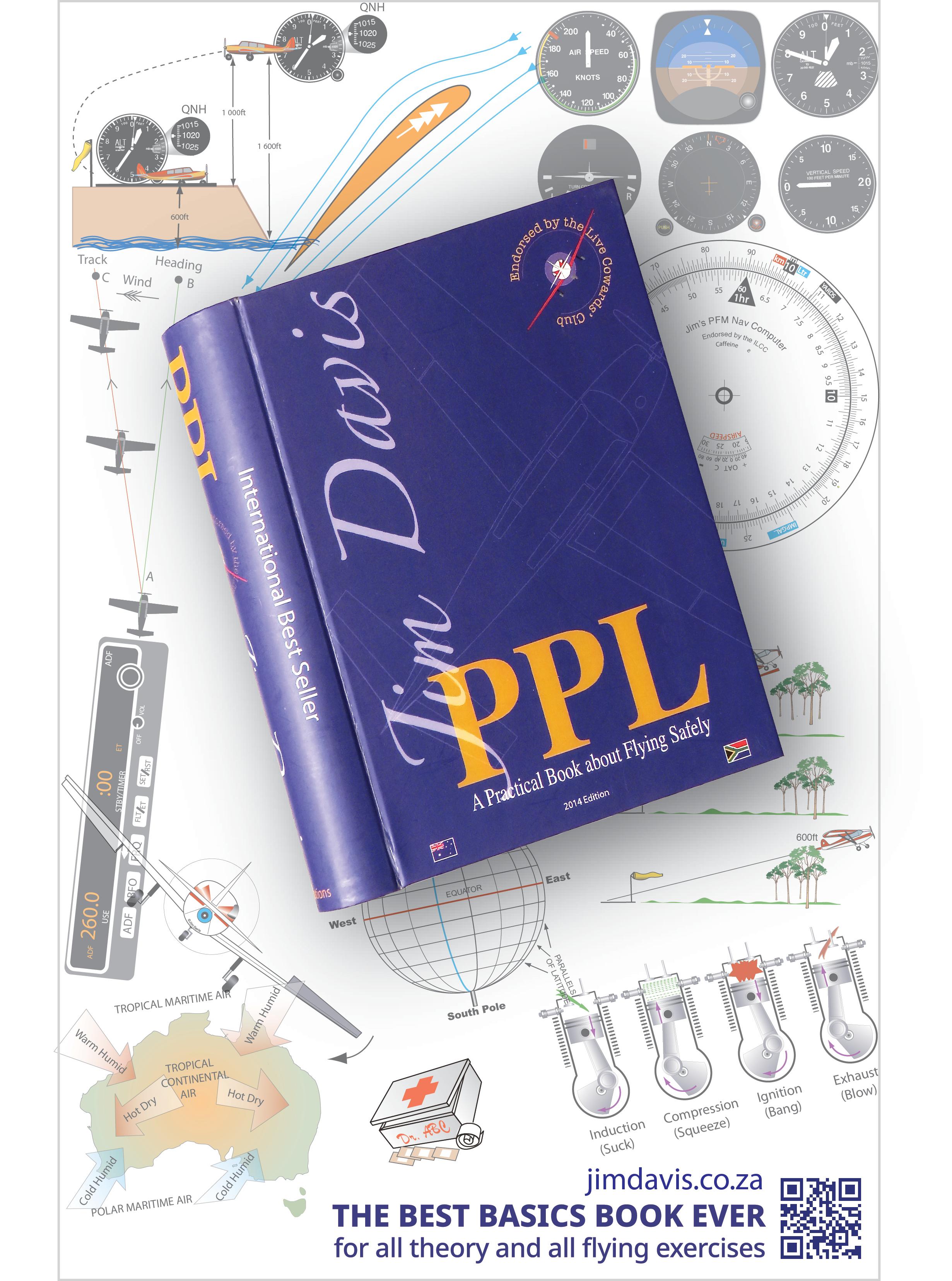
We elevate the ar t of aviation design to new heights. Our innovative approach blends cutting- edge technology with timeless elegance, transforming aircraf t into personalized sanc tuaries of comfor t and style. From bespoke seating & advanced cabin layouts to exquisite liveries, we craf t ever y detail to ensure your journey is as ex traordinar y as your destination.

Liver y Design
Photorealistic 3D previews
Photography











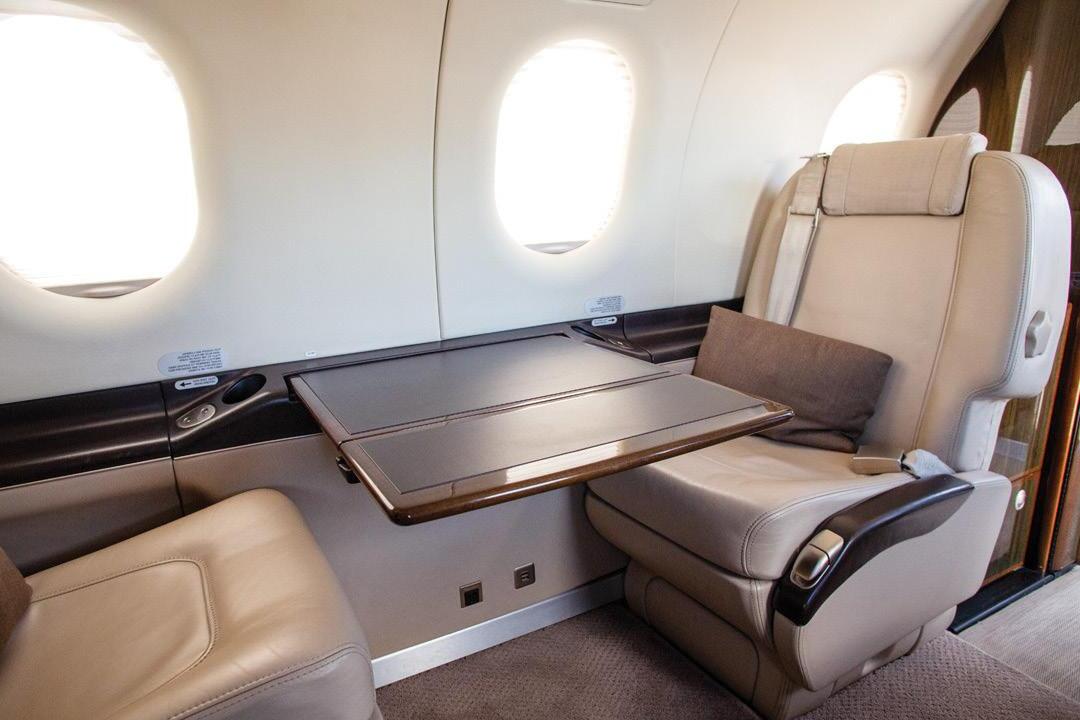










Day and night, the fun doesn’t stop!
Our catered camp site on the airfield means you won’t miss out on any of the activities – the early morning wake up call of P 51’s getting airborne, the evening ultralight parade, the STOL competitions and of course, the incredible night airshows! Plus all the camaraderie and fun only a camping group can offer.


Our campsite offers you a home from home at Oshkosh, tents and bedding, meals and beverages, charging facilities and sheltered seating – no camping gear required, bring only your clothes!
Tours depart Johannesburg, Durban or Cape Town Friday 18th July and return Tuesday 29th July 2024.
Prices from R40 650, Early Bird specials available!
Guy Leitch and Jim Davis

SA Flyer owned a Saratoga II TC and this top of the range model has tended to overshadow the early basic Togas which were Piper Lances with the tapered wing. It may have been a basic beginning, but Jim Davis reckons it’s still a great plane.

Jim Davis writes, “The Saratoga gives you the best of both worlds – cabin class luxury and single economy.” I wrote that nearly 50 years ago after flying one around ‘the border’ for a few months.
More recently I did a few hours in a 2005 model, and my opinion has not changed – it’s still a really impressive aeroplane.
could chuck a couple of drums of fuel in the back, or up to four stretcher cases. Two on each side – one above the other.
And like the 235, the Six is one of the few aircraft that can carry more than its own weight. That one weighed just 1665 lbs and could carry 1735 lbs to give it a gross weight of 3400 lbs.

Beautiful? Naaah. It’s far from pretty. It lacks the grace of a Cessna 310, or the functional beauty of a single Comanche. But it is has more cabin space than both, and it’s faster than a Comanche, so perhaps beauty is not everything.
In 1966 I flew its ancestor, a 260 HP Cherokee Six, Echo India India. It was the first Six in the country and I was much impressed – it was a young airliner. You
Unfortunately aeroplanes and cars get heavier with each new model. I have a brochure for the 1982 300 HP turbo retractable Saratoga – its empty weight has gone up by 413 lbs, but the gross has only increased by 215 lbs. This means that despite the extra power and fancy semi-tapered wings, you are 200 lb worse off.

I can give you figures for all the different models, but that’s boring. So let me rather tell you about Lima Golf Romeo, which was a normallyaspirated 1983 SP with retractable gear, because that’s the one on which I have most time.
I bullied the South West Administration into buying this aeroplane, brand new, for R141,375. They used it mainly for casevacs.
The Saratoga is so much more aeroplane than the Cessna 210, and yet look at who has the lion’s share of the market in Namibia – Cessna just had a far better marketing team.
Talking of marketing, with the first Cherokee Sixes, they threw in four magnificent pig-skin suitcases that exactly fitted in the front luggage
compartment. Oh, and they left the price tags on. Once mama saw that, she told pappa which was the best aircraft.
The Saratoga has come a long way since the old Six. Gone are the ponderous handling and sluggish performance of the Six. Gone, too, are the spartan appearance and indifferent finish that characterised the early Pipers.
The old Boere-Boeing was a great workhorse, but it was separated from the Saratoga by three main



points: first the semi-tapered wing, which gives noticeably better short-field performance. It also lets the aeroplane glide rather than plummet. And Piper claims better cruise speed and economy.
Second, the retractable gear has an obvious speed advantage.
And finally, Piper adopted a ‘new image’ policy intended to give Ford utility with Cadillac quality. They even used the Cadillac upholstery people to supply the interiors. The Crushed Velour material is comfortable – even luxurious –and time has proved it to be extremely durable.
And now for some of the things I didn’t like. There is no ‘door ajar’ light on the panel. This means you have to wait until your back seat pax are seated and then check that both halves of the massive back door are closed properly.
Next, there are two interconnected tanks in each wing. This makes for easy fuel management, but it means you can’t see the fuel in the inboard tanks through the filler, so you have to rely on
sight gauges in the wings. I hate it, even though the gauges are pretty accurate.
The next problem has no cure. The oil filler and dipstick is very high on the top of the engine, particularly if you have the nose oleo well inflated to keep the prop away from the gravel. It’s okay for six footers, but the rest need to find something to stand on.
The final annoyance is the old low-wing problem. Older folks and girls in tight skirts are pretty much restricted to using the back door – which is comfortably low to the ground.
I love the way you can clip out the four back seats in a couple of minutes to make way for cargo. We had to take a stretcher case from Rundu to Windhoek soon
after I arrived. The double back doors make loading seem like a stroll through Marble Arch. The luggage went in the front compartments, while a doctor and a nurse sat next to the patient.
The instrument panel and control layout uses the basic design that has been standard on Pipers for many years. It is
it worked like a charm. It handled the Namibian turbulence more comfortably and accurately than many pilots.
The automatic gear extension system (inherited from the Arrows) works with an uncanny reliability. You can override it for obstacle clearance climb out of short fields. A flashing light and audible

well thought out and functional. If you have flown other Pipers, you will feel at home behind the controls of a Saratoga.
The very wide cabin is not only comfortable, it gives you panel room to fill up with dual everything in avionics. We had a King KFC 200 auto-pilot and
warning tell you if you are using low power with the override on. This makes the system foolproof, if not idiot-proof.
Luckily Lima Golf Romeo had those beautiful manual flaps that Piper has used since the beginning of time. However two years later, in 1985, they did

the unthinkable and put in an electric motor and a whole lot of wiring to make the aircraft heavier, less reliable and less pleasant to fly.
For night flying, the panel lighting is excellent. You can adjust it through three different controls to give exactly what you want.
The 300hp fuel-injected Lycoming is a pleasure to start, hot or cold. Simply do what the book says and the three blades blur into a disc as she rumbles into life. The front baggage compartment does a splendid job of sound deadening.
To taxi the Saratoga you need strong legs. The weight of that engine on top of the nosewheel makes for heavy steering unless you have a lot of weight in the back. Visibility on the ground is excellent, even over that long nose, and she can turn in very confined spaces. The 3.4m track between the main wheels makes it incredibly stable on the ground. There’s never any need to tie the aircraft down, and gusty crosswinds during landing or takeoff are a breeze.
Talking of takeoff, this is one area where the Saratoga surprised me. The heavy stick loads at rotation make you think that she doesn’t want to fly. Nothing
could be further from the truth, as one pupil demonstrated. We were taking off from Eros, Windhoek, at gross weight, with six up, on a hot, airless afternoon with the density altitude at over 9000 feet. I told the pupil that I wanted him to rotate gently at 85 knots. Well, he got it wrong and we suddenly found ourselves climbing out enthusiastically at 75.
Another time we went into an extremely narrow and sandy bush field. The landing was easy – the deep sand brought us to a halt in an impressively short distance.
For a soft field takeoff the book recommends full flap. At first I hesitated to do this because of the tremendous drag, but eventually decided to comply. After a few metres of skidding and pulling sideways as the wheels dug into deeper patches, we were suddenly on top and accelerating strongly. In this configuration she lifted off at 60 kts and climbed eagerly.

For handling, I would give the Saratoga eight out of ten for normal flight, where she has that solid bigaircraft feel. But only six out of ten for low speed flight, where she becomes heavy and soggy. She actually handles well below 80 knots, but you have to get used to large control inputs, particularly on the ailerons.
Stalls, ranging from clean with no power, to everything hanging out, and full power, are gentle and honest. You get about 10 knots of warning hooter, followed by a slight shudder and the nose dips with the wings level. With full power she reaches an unbelievably nose high attitude, and needs almost full right rudder.
Unlike most aircraft, Pipers usually perform better than book. Speed and fuel consumption were the only ones
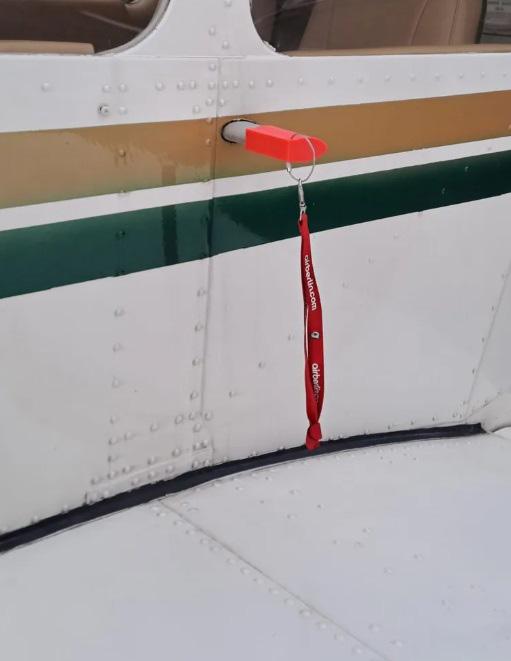

I could measure accurately on ZS-LGR, and she comfortably exceeded expectations.
At gross, and using 65% power, we constantly got a TAS of 162 kts (3 kts better than book). And the indicated stall speeds were a couple of knots slower than book – possibly position error.

For range, at 65 per cent, using ‘best power’ mixture, the book gives 865 NM (with 45 mins reserve). In practice I found I could comfortably plan on 900 NM with reserves. These were not one-off figures – they were honest, every-day working figures.
On the 330 nm trip from Rundu to Windhoek, which I did often, we were always about ten minutes faster than the 210s which proliferate in Namibia. Perhaps that’s because Lycomings are happy with 75% power (government fuel) and the Cessnas were probably using the maximum recommended 70%.
Let’s have a look at claimed figures. The Saratoga figures are from the POH, the rest are difficult to pin down - they seem to vary from source to source:
The Saratoga is not quite as fast as the other two, but, paradoxically, it might get there sooner. On a flight from Johannesburg to Cape Town, nominally 700 nm, the Bonnie will get there first, with the 210 only 3 minutes behind. The Saratoga brings up the rear by landing 13 minutes after that. But the slightest headwind will have the other two scuttling into Bloemmies for fuel, putting the Piper way ahead.
Finally, the Piper’s Lycoming has a longer life, is more robust and cheaper to operate than the Continentals in 210s and Bonnies.
Since the first PA-32 came out 57 years ago, it has always been an underrated aeroplane – much like the 235 Cherokee.
Aircraft Registration: ZS-JZN
Date of Accident: 5 November 2004
Time of Accident: 1600Z
Type of Aircraft Piper: PA 28-140
Type of Operation: Private
Pilot-in-command License Type: Private
Age: 26
License Valid: Yes
PIC 97.5 Hours. On Type: 26
• This discussion is to promote safety and not to establish liability.
• CAA’s report contains padding and repetition, so in the interest of clarity, I have paraphrased extensively.
Point of departure George: (FAGG)
Point of intended landing George: (FAGG)
Location: Open field in Mossel Bay GFA Met: 180/10kts; +20C. Broken at 5000-7000’.
Number of people on board: 1 + 0
No. of people injured: 0
No. of people killed: 0
Synopsis:
The CAA’s Synopsis
The pilot stated that while he was practicing simulated forced landings in the Mossel Bay General Flying Training area during a “go-around” the aircraft collided with telephone wires. After colliding with the high tension wires it was difficult to control the aircraft and he decided to execute a forced landing in an open field.
The last Mandatory Periodic Inspection (MPI) prior to the accident was certified on 11 November 2004 at 11210 total airframe hours and the aircraft was operated for 73 hours since the last MPI was certified. All the applicable Service Bulletins (SB) and Airworthiness Directives (AD) were complied with.
The aircraft was substantially damaged, but the pilot was not injured. He attributed the accident to his lack of knowledge of the training terrain.

The pilot flew the aircraft at low level altitude over an unknown terrain and failure by him to look out resulted in the aircraft colliding with the high-
tension wire, rendering the aircraft controllability difficult and a forced landing was executed in an open field.
They say you should not speak ill of the dead. No the pilot didn’t die – in fact he wasn’t even injured – but the brave little aircraft never recovered, she died while protecting the pilot from his idiot behavior.
And now I’m afraid I have to admit she was undoubtedly the worst aeroplane of the 40 or 50 I have ever owned. And no – I didn’t own her at the time of the accident.
I always maintained that you don’t need to see an aeroplane before you buy it – a couple of photos maybe – but the logbooks are the real deal breakers. I was wrong.
I bought this little Cherokee sight unseen. I collected her in Port Elizabeth to fly her to her new home in George. As the wheels left the ground I was hit by a wave of what I believe is called buyers’ remorse. She seemed to be

unhappy to be in the air – almost as if she was flying sideways – but she wasn’t. There was a nasty vibration which no amount of subsequent prop balancing could cure. Even after an engine overhaul she persisted in rattling the fillings out of one’s teeth and drinking oil.
Actually I was amazed to see that she had survived for over 11,000 hours – she had done about 3000 when I sold her. Poor little thing.
Enough sentiment already.
You know when the cops stop you for speeding and you tell the officer you are on the way to see your dying grannie in hospital, and the cop gives you and old-fashioned look and continues writing out a ticket? Well the CAA gets the same look in it’s eye when you are standing next to a smoking wreck entangled in wire, and explain you were being such a good guy and trying to hone your precautionary skills. They recognize BS when they see it.
So this low-hour pilot was doing low-flying just before sunset when he bumped into Eskom’s main feed to Mossel Bay.
As this is not a complicated accident that needs a lot of analysis let me steal a bit of space to tell
you about another aircraft that also cut off the main electrical supply to Mossel Bay – perhaps in the same place.
I had my head inside the cowl of my little Colt – Charlie X-ray Charlie. It had a habit of oiling the plugs – mainly because I couldn’t afford the top-overhaul which it desperately needed. This meant that I often found myself burning my fingers on hot engines while changing and cleaning plugs. While I was working I glanced back to find someone standing behind me. It was Derek Dumbleton, a jovial crop-sprayer.
“Lucky Jim,” he said. He always called me that. “The roof has come off my office.”
“I didn’t know you had an office, Derek.”
I replied while I continued to work. Cropspraying pilots generally don’t need offices. Besides I was simply not interested in his problems – I had my own to keep me busy.
“Come and have a look,” he suggested.
“Derek, I’m working.”
“No, just come – it won’t take a minute. It’s right here.”
I gave up, unfolded myself from under the cowl and looked round to see Derek pointing at his Pawnee. When I first glanced at it something didn’t look right, and then I realized what the problem was – it had no cockpit. Absolutely nothing at all.
“What the bloody hell happened?” I asked.
“I cut Mossel Bay off the grid,” he explained.
I went to look at the aeroplane. Apart from having no cockpit, it also had a massive burn hole in the right hand compression strut which holds the wing on. When I say massive, I mean that it looked as though a vindictive welder had cut most of the strut away, about half way down its length. The left hand undercarriage leg was also blackened and half burned away.
Eventually the story came out. Derek had been crop-spraying a few miles inland from Mossel Bay when he sailed straight through a bunch of power lines. Actually the main ones that feed the town. He had completely blacked the place out. He then flew back to George with head and shoulders sticking out in the airflow above the fuselage. Like someone in a canoe.
And he had the nerve to call me Lucky Jim.
Okay so it’s time to be serious about low flying. What two main precautions should you take before you go low flying? Think about it before you look.
1. Have a good look at an up-to-date largescale, say 1:500,000, topographical map to see if there are any power lines or radio masts in the area.
2. Clean the windscreen properly. Actually this is a precaution we should take before any flight. Even if you don’t plan to go low flying you might find yourself doing a precautionary or forced landing. Or landing into the setting sun because ATC told everyone that’s the runway in use, and you are reluctant to make a fuss. Even if it’s nothing to do with landings, you don’t want to be wondering whether that’s a bug on the windscreen, or bird, or a chopper. I don’t think I am a cruel bastard but I would be one if someone pitched for a flight test with a dirty windscreen.
Okay so here’s a more comprehensive list of stuff to think about before you go low level.
• The legal implications of low flying. 500’ min but you may go lower so long as you are not a ‘danger or nuisance to persons or property on the surface’.
• The choice of a good area for low flying.

• Position of the sun.
• Wind strength and direction.
• Density altitude.
• Passenger briefing.
• Fuel selection and pump.
• Trim.
• Possible conditions for carb-icing.
• Power and mixture settings.
• Engine cooling.
• Poor VHF range.
• Location of birds (lakes, rubbish dumps etc).
• Avoidance of birds.
• Rising ground.
• Loose articles.
• Harnesses.
• The dangers of wires.
• The dangers of valleys.
• The dangers of open water.
• The dangers of large expanses of sand.
• Airspeed/groundspeed relationship.
• Apparent skid and slip in turns.
• Keeping your hand on the throttle.
• Lookout, particularly ahead.
• Distractions – inside and outside the cockpit.
• Low-level navigation.
A couple of months ago I wrote about a 4000 hour pilot who killed himself in a Colt circling over a friend’s house in a 10 knot wind. If you haven’t had dual on turns-around-a-point don’t even think of trying to do any of the following if there is more than about 5kts of wind.
• Circling to photograph a building
• Flying round a herd of animals
• Circling round a beauty spot
• Herding animals for game capture
• Circling or following sports – cycling or motor racing
• Banner towing or advertising
• Tourism flights
• Circling a boat or yachting event is particularly dangerous
• Circling any moving object.
Wires cross valleys and pylons hide behind trees.
I came withing a camel’s whisker of hitting a sand-dune while descending on long final for runway 12 at Luderitz in Namibia. Sand dunes are nnotorious for optical illusions.
Guys and girls – low flying is bloody dangerous for so many reasons you haven’t even thought of.
Flying over water or sand dunes has killed experienced pilots who thought they knew what they are doing because you lose your depth perception if you don’t have recognizable objects nearby. j

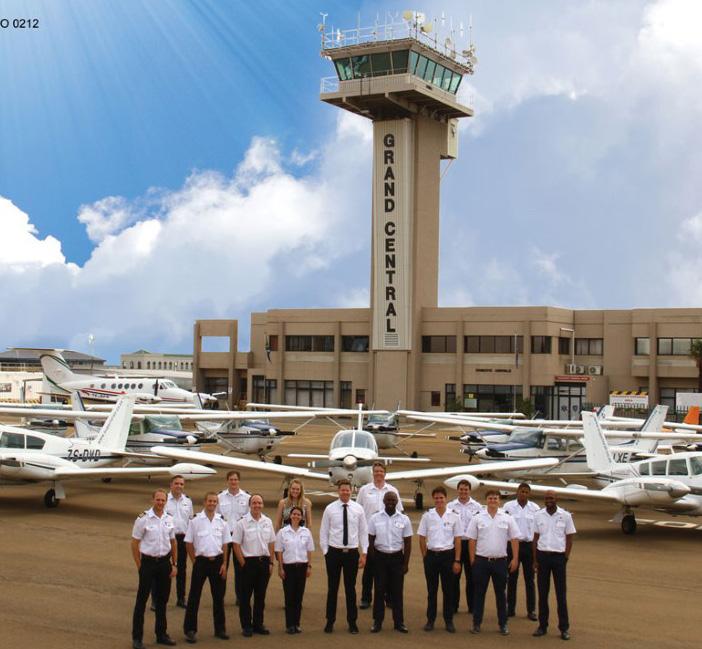





OPERATING FROM GRAND CENTRAL Airport in Midrand, Superior Pilot Services prides itself in its wealth of knowledge and experience in the aviation sector, offering a variety of certified courses, from the Private Pilot’s Licence to the Airline Transport Pilot Licence, Instructor’s Ratings and Advanced training. The school specialises in personal outcome-based training and combines the latest techniques, methods and training aids to maintain a high level and standard throughout. Superior is proud to have been selected as a service provider to numerous institutions like, TETA, Ekurhuleni Municipality, KZN Premiers office, SAA, SA Express and SACAA cadets, however their ideally situated location allows the general aviator and businessman to conveniently access and utilize the same services.
With highly trained and qualified instructors and a fleet of Cessna 172s, a Cessna 182, Sling 2, Piper Arrow, Piper Twin Comanche and R44 helicopter, the school has the know-how and experience to prepare the best pilots in the industry. Making use of a state-of-the-art ALSIM Flight Training Simulator, the Superior Aviation Academy offers unmatched facilities that ensure students’ social needs are catered for and that the training offered is at the forefront of international training standards. The Alsim ALX flight simulator model provided by Superior Pilot Services is EASA and FAA approved and has proven itself worldwide. It provides up to four classes of aircraft and six flight models that cater from ab-initio all the way to jet orientation programmes in one single unit available 24/7.
The school offers a range of advanced courses, including IF Refresher Courses, Airborne Collision Avoidance System (ACAS), GNSS/RNAV, CRM and Multi Crew Coordination (MCC) conducted by its qualified instructors. The school also offers PPL and CPL Ground School and Restricted and General Radio Courses. Superior Pilot Services has accommodation available. The lodge is conveniently located just six kilometres from the airport. All rooms are based on a bachelor’s unit which includes laundry and room cleaning services as well as breakfast. Students have access to the communal lounge, gym and entertainment room, pool and ‘braai’ area.





Cemair's CRJ900 ZS-CMM with big billboard Avis titles applied. These were previously on a CRJ200 but now replaced by the 900. Seen on approach to JNB on 6 October.
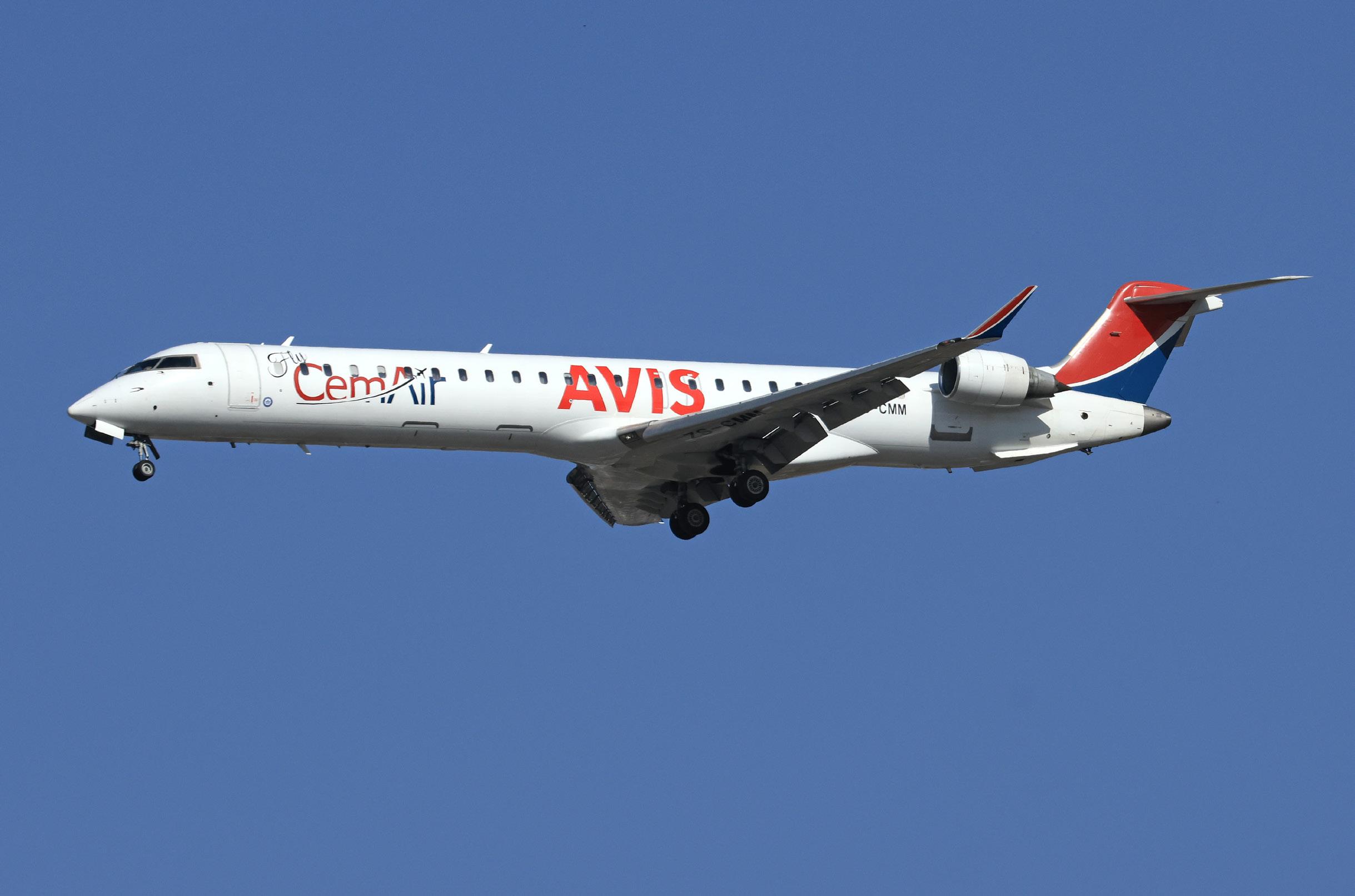
The September registration updates is a mixed bag of imports and exports. We see five type-certified fixed wing planes being registered during September, but no helicopters.
A BRAND-NEW PILATUS PC-24, ZS-NID, was delivered for the transport and logistics company Ni-Da, replacing their earlier model PC-24 that has been sold to a new owner, also based in South Africa. Few corporate jet owners have any branding or company names on the aircraft but Ni-Da proudly proclaims their ownership of this lovely new jet. The PC-24 is carving out a popular niche market in the country as this is the seventh of these jets to be registered in South Africa. It was delivered on 5 September and has entered service.
Global Airways has acquired another Airbus A320, ZS-GAB that will be wet leased by Gabon’s AfriJet and will fly under the Fly Gabon banner. The aircraft arrived at OR Tambo on 12 September in basic Etihad Airways livery and with its former registration, N2167, still applied. This Airbus was delivered new to the Dutch carrier Martinair in April 2004. It later joined the Etihad Airways fleet in December 2007 until it was withdrawn from service and stored at Abu Dhabi in November 2020. The plane was subsequently ferried to St Athan in Wales in November 2023 where it was noted with Fly Gabon titles

ABOVE: ZT-RON is a Bell 505 now exported to the Phillipines.
BELOW: ZS-FIX, a Cessna C182 Skylane was a contemporary of SA Flyer's ZS-FPI and has been cancelled as crashed.


ABOVE: ZS-OAP was a well known kulula Boeing 737-400 - now cut up for scrap.
BELOW: Cemair's fleet of CRJ900s is growing steadily and a recent addition is this rather anonymous looking one seen on approach to JNB on 6 October.

applied in August this year. It was ferried to Libreville on 11 September and arrived at OR Tambo the following day. I look forward to seeing and photographing it in its new Fly Gabon livery soon.
The Beechcraft 1900D is a popular type in South Africa for domestic airline and charter operations and also for placing on the contract market in Africa, the Middle East and Asia. This month sees another added to the local registry as ZS-BGM (UE354). The owner was previously listed as Barrick Goldstrike Mines and I would hazard a guess that is still the case from its new registration. Interestingly this registration was previously allocated to a very early model Be1900C (UC4) that was sold to Swedish operator Jonair Affäsflyg earlier this year and reregistered SE-MJV. This is probably their replacement plane to operate in support of their African mining operations.
A type we don’t see much of in South Africa anymore is Cessna’s ‘push-pull’ 337 Skymaster. Last month we saw one of these distinctive planes being added to the NTC register and this month a second follows, albeit a typecertified one that has been operating for the City of Cape Town for some time with its American registration N932AS. This threeyear R126 million contract to enhance its crime prevention capabilities with advanced aerial surveillance technology awarded by the city’s Safety and Security Directorate earlier this year raised some eyebrows, especially as this plane was not on the South African civil aircraft register. This has now clearly changed. The last plane added in September is also a Cessna, albeit a single engine model 182S.
The NTC fleet shows continued strong growth this month with 10 new additions for September in the updates. It’s been a while since any new gyrocopter registrations were noted, but this month sees a Magni M24 Orion gyrocopter registered. This is the flagship of the range and named after the Greek God Orion who was “the most handsome and imposing of the men”. It has a fully enclosed cockpit with side-by-side seating and is equipped with dual controls. It is powered by a 115hp Rotax 914 turbo engine and has an endurance of up to four hours.
Mbombela-based Bat Hawk Aircraft have sold a pair of Bat Hawk light sport aircraft (LSA) which they describe as the “most affordable LSA on the market”. A single Airplane Factory Sling TSi and a Shadow Lite Jabiru J430 complete the proudly SA-made additions for the month.
Two RVs join the large number of these popular types with one each RV-6 and a RV-10 being registered.
Weight-shift ultralight trikes are another type that recently feature less frequently in this column, but this month sees a Frenchmanufactured DTA Voyageur II ZU-JBL registered. These aircraft were designed by Jean-Michel Dizier and produced by DTA sarl of Montélimar and are supplied complete and ready to fly.
The last addition is a Aerospool WT9 Dynamic LSA manufactured in Slovakia. This is a sleek two seat low-wing design.

ABOVE: N932AS is a Cessna T337H seen here at Zagreb. Now registered as ZS-ASG and operating on anti-crime patrols in Cape Town.
BELOW: ZS-NID is the second new Pilatus PC-24 to be bought by Ni-Da truckers.

Another of the short-lived ZS registered corporate jets has moved on, as predicted in this column, to Russia. This time it is the Falcon 7X, ZS-LOV, that was registered in South Africa in July of this year.
The Cessna 208B Grand Caravan ZS-CXD that ferried to Australia in August has now been cancelled from the ZS register as being exported to Australia. As mentioned in last month’s Register Review, the ATR72-600 ZS-LIZ has also been cancelled as exported to Gabon where it has been operating for Fly Gabon for more than a month.
Boeing 737-4S3, ZS-OAP has been cancelled as scrapped. This 737 had been part of the low cost carrier Kulula’s fleet and painted in the whimsical “Flying 102” livery but was parked at OR Tambo in 2020 for Covid and Comair’s subsequent liquidation. It was seen being cut up at the airport in August.
It is unusual to see not one but two helicopters cancelled as exported to the Philippines:- a Bell 505 ZT-RON and MD-500E ZT-RZZ. I wonder if they have both gone there on contract work?
Finally, there is only a single NTC type deregistered this month - a Savanna S noted as exported to Benin.
In closing this month, I cover a few new and notable aircraft and events that have not yet been recorded in this column from the SACAA-supplied updates.
Another deletion is that of a Cessna 182L, ZS-FIX with the reason for its cancellation being due to an “accident”. A quick search on the internet reveals that the plane suffered a runway overrun on landing at Kokstad in February 2006 but was subsequently repaired and last noted at Rand Airport on 17 April of this year. I am not sure why its cancelled as destroyed as I cannot find a reference to it being involved in a crash subsequent to this photo being taken? Perhaps one of our readers can shed more light on this matter?
On 12 September another geriatric 1978 model Citation ISP, N9ZB (501-0047) arrived on delivery to its new local owner. It has been flying out of Wonderboom Airport with its American registration so it’s unclear if it will take up ZS registry.
Another new delivery is a brand new super mid-size Bombardier Challenger 350, ZS-AKF (21023) that arrived at OR Tambo International Airport on 1 October from N’Djamena. This is the first of the upgraded Challenger 3500s delivered to SA. The model was announced in September 2022 with a redesigned interior, technology updates, a lower cabin altitude and the availability of the patented Nuage seat. While launched as the Challenger 3500, these are still seemingly referred to as Challenger 350s. This is the second use of this registration on a Challenger 350, this previously carried on c/n 20870 which was subsequently sold and now flies as N923JL.

In September, several photos were published on social media showing a HS125 corporate jet being towed through the streets of East London from the King Phalo Airport to an unnamed church in the city where it is reportedly to be put on display. The livery matches that of ZS-TBN, a 1965 vintage model HS-125-F1A (025023) that was previously operated by Trinity Broadcasting Investments. This plane was parked in a derelict state at the East London Airport for several years until its recent move to its new (and probably final) home.
On 17 September jihadist gunmen attacked several locations across Bamako, including the Mobido Keita International Airport. Video footage emerged afterwards of a Beechcraft 1900D, ZS-JAG (UE115), operated by National Airways Corporation on behalf of the UN’s World Food Programme, that
was riddled with machine gun fire while an unsuccessful attempt was also made to burn it by setting fire to a motorcycle under the port wing. Video footage circulated on social media shows extensive damage, so it is very likely that this plane will be written off as damaged beyond economic repair. This is a sad and unnecessary loss of a plane that was performing humanitarian work in support of the citizens of Mali.
ZS-TMK
ZS-FIX
ZU-JAT

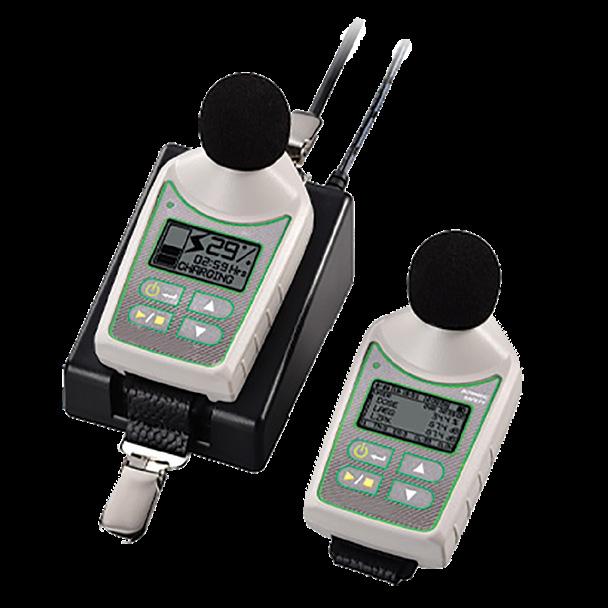


The FAA has released final rules for the air taxi industry to begin commercial operations.
AIR TAXI COMPANIES have been waiting for the rules, which they’ve said will offer clarity that’s crucial for them to start commercial flights in the US as soon as the end of next year.
The FAA said that the regulations are the “final piece in the puzzle for safely introducing these aircraft in the near term.”
Leading air taxi developer Joby’s share price surged 12% while Archer’s stock rose 6.4%. Joby and Archer are still waiting for the FAA to certify their vehicles.
Toyota Motor Corp. is boosting its investment in Joby by $500 million, bringing its total stake to $894 million. Delta Air Lines. is also an investor in the firm, which plans to fly people to airports
in New York and Los Angeles. Stellantis NV, the European carmaker that owns Chrysler and Fiat, is the largest shareholder in Archer.
The FAA said in its statement that these aircraft, which it refers to as “powered lift,” are the first completely new civil category to be introduced since helicopters in the 1940s.
The FAA made changes in the final package that companies sought after seeing the proposed rules in 2023. That includes allowing flight training in aircraft that have single controls. A previous version required dual controls, which the industry argued would’ve forced them to take the costly and time-consuming step of designing a different model just for that purpose.
The new regulations are an important step forward. j

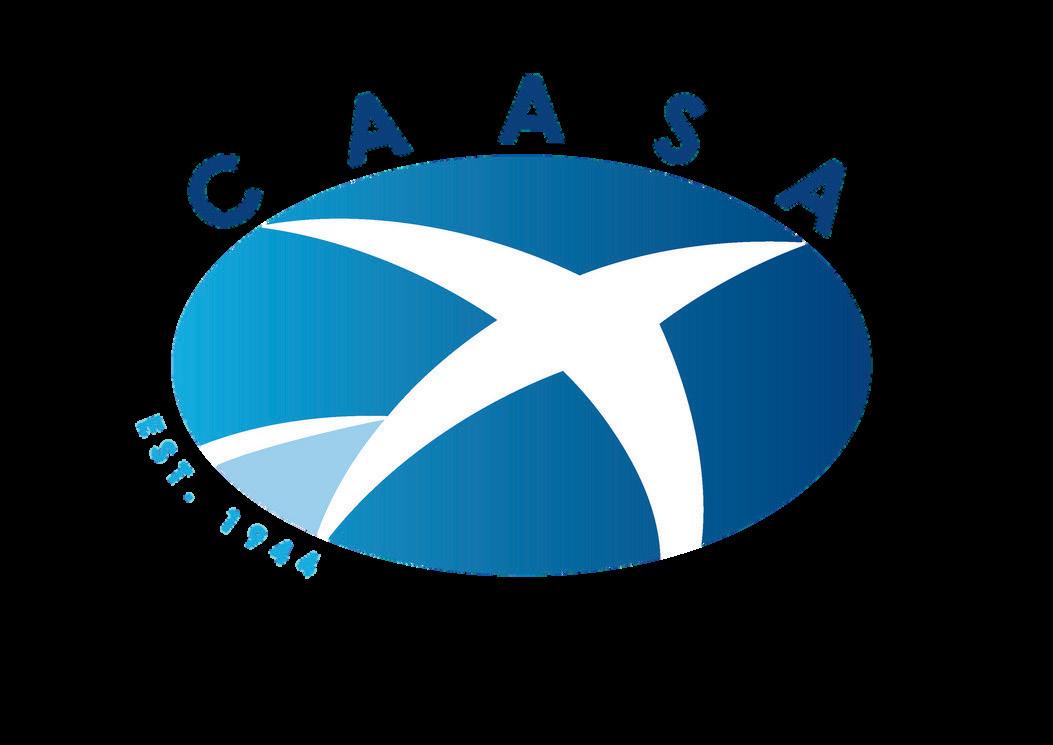



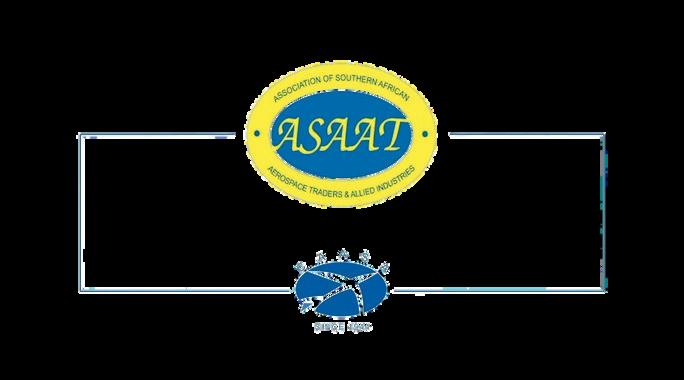











• Now certified for TCAS training.
• RNAV and GNSS Certified on all flight models from single engine to turbine.






Baragwanath - FASY
R34,00
Beaufort West - FABW R31,60 R 23,10
Bloemfontein - FABL R33,04 R18,74
Brakpan - FABB R33,80
Brits - FABS R28,30
Cape Town - FACT R33,93 R19,96
Cape Winelands - FAWN R33,00
Eagle's Creek R30,50
East London - FAEL R35,70 R18,93
Ermelo - FAEO R31,51 R24,73
Gariep Dam - FAHV R32,00 R23,00
George - FAGG
Baragwanath - FASY
Beaufort West - FABW
Bloemfontein - FABL
R34,00
R29,30 R 23,10
R33,04 R18,74
Brakpan - FABB R33,80
Brits - FABS R28,30
Cape Town - FACT R33,93 R19,96
Cape Winelands - FAWN R33,00
Eagle's Creek R29,50
East London - FAEL R35,70 R18,93
Ermelo - FAEO R29,79 R24,73
Gariep Dam - FAHV
R35,77 R18,94 George - FAGG
Grand Central - FAGC R32,49 R20,99
R29,50 R20,00
R35,77 R18,94
Grand Central - FAGC R32,49 R20,99
Heidelberg - FAHG R29,33 R21,28 Heidelberg - FAHG R28,90 R20,30
Hoedspruit Civil - FAHT NO FUEL NO FUEL
Hoedspruit Civil - FAHT NO FUEL NO FUEL Kimberley -
Klerksdorp - FAKD R32,00 R22,42 Klerksdorp - FAKD R32,00 R22,42 Kroondal / Airspan R27,20 R19,49 Kroondal / Airspan R26,93 R18,02 Kroonstad - FAKS R31,63 Kroonstad - FAKS R31,63
Kruger Mpumalanga Intl -FAKN R35,15 R26,30 Kruger Mpumalanga Intl -FAKN R35,15 R26,30 Krugersdorp - FAKR R30,00 Krugersdorp - FAKR
Middelburg - FAMB R31,75 R20,50 Middelburg - FAMB R29,50 R20,50 Morningstar R30,95 Morningstar R29,95 Mosselbay - FAMO R35,50 R27,00 Mosselbay - FAMO R35,50 R27,00
Nelspruit - FANS R32,26 R23,00 Nelspruit - FANS
Oudtshoorn - FAOH R33,05 R23,10 Oudtshoorn - FAOH R33,05
Parys - FAPY R27,77 R20,07
Pietermaritzburg - FAPM R31,40 R23,00
Port Alfred - FAPA R33,50
Port Elizabeth - FAPE R35,08 R22,08
Potchefstroom - FAPS R27,20 R19,49
Rand - FAGM R33,50 R23,50
Robertson - FARS R31,90
Rustenburg - FARG R31,50 R23,00
Secunda - FASC R29,33 R21,28
Skeerpoort *Customer to collect R24,95 R17,25
Springbok - FASB R31,70 R23,50
Springs - FASI R37,25
Stellenbosch - FASH R35,00
Swellendam - FASX R31,50 R23,00
Tempe - FATP R31,64 R21,01
Thabazimbi - FATI R27,70 R19,99
Upington - FAUP R36,62 R24,76
Virginia - FAVG R33,58 R20,64
Parys - FAPY
Pietermaritzburg - FAPM

NO FUEL NO FUEL
Port Alfred - FAPA R33,50
Port Elizabeth - FAPE R35,08 R22,08
Potchefstroom - FAPS R26,93 R18,02
Rand - FAGM
Robertson - FARS
Rustenburg - FARG
Secunda - FASC
R33,50 R23,50
R31,90
R30,00 R21,95
R29,33 R21,28
Skeerpoort *Customer to collect R24,69 R15,78
Springbok - FASB
Springs - FASI
Stellenbosch - FASH
Swellendam - FASX
Tempe - FATP
Thabazimbi - FATI
Upington - FAUP
Virginia - FAVG
Vryburg - FAVB R28,35 R20,25 Vryburg - FAVB
Vryheid - FAVY R27,20 R19,49
R29,50 R23,50
R37,25
R35,00
R30,70 R23,00
R29,16 R19,86
R27,43 R19,30
R36,62 R24,76
R32,09 R20,64
Whenever the annual calendar of events is put together at the beginning of the year, October always seems like a million miles away. And so inevitably the EAA Sun ‘n Fun fly-in arrives far sooner than anticipated.
More than 70 aeries flew in.

THE SPAR UP THE ROAD from where I live is already selling Christmas cake and I know that when Boney M starts blaring through the speakers, the battle for any semblance of control over the remainder of the year will dissipate faster than a logical thought in the chaos of a mind gripped by year-end panic.
On Friday morning, Neil Bowden, chairman of EAA chapter 322, offered Seamus The Flying Dog and I a lift to Airspan Executive Airfield in Rustenburg, the appointed event for Sun ‘n Fun, in his much loved Sling 2 ZU-OSH.
I knew that we would be in for a sweltering weekend when I saw the heat waves shimmering on the tarmac as Neil turned final for Runway 21.
We unpacked the Sling and proceeded to the huge hangar which houses the entertainment area and pub to set up our stand. The management at Airspan had made a superb
effort to accommodate the event and the restaurant staff were in full swing preparing meals.
Safety Officer Nigel Musgrave arrived with Kulani, a regular ATC at FALA, both offering up their valuable time to be at this event. Nigel had some positive feedback about the CAA relaxing the regulations regarding the participation of ATC at unregistered airfields, now permitting them to offer their services (at their own cost) provided that a safety officer is always present.
By late afternoon more than a dozen planes as well as a few cars had arrived. Fifteen rent-atents had been arranged near the conference centre with a few folk bringing their own tents and caravans.
The clouds coalesced to offer some respite from the scorching heat, but the predicted storm thankfully stayed away.


ABOVE: The fully furnished rent-a-tent homes.
BELOW: A pair of helis had great fun.






Paul & Laura award winners of the ANR Tarryn Myburgh and Adrienne Visser.

Winner of the spot landing Dale de Klerk fixing a flat tyre whilst the onlookers offer encouragement.

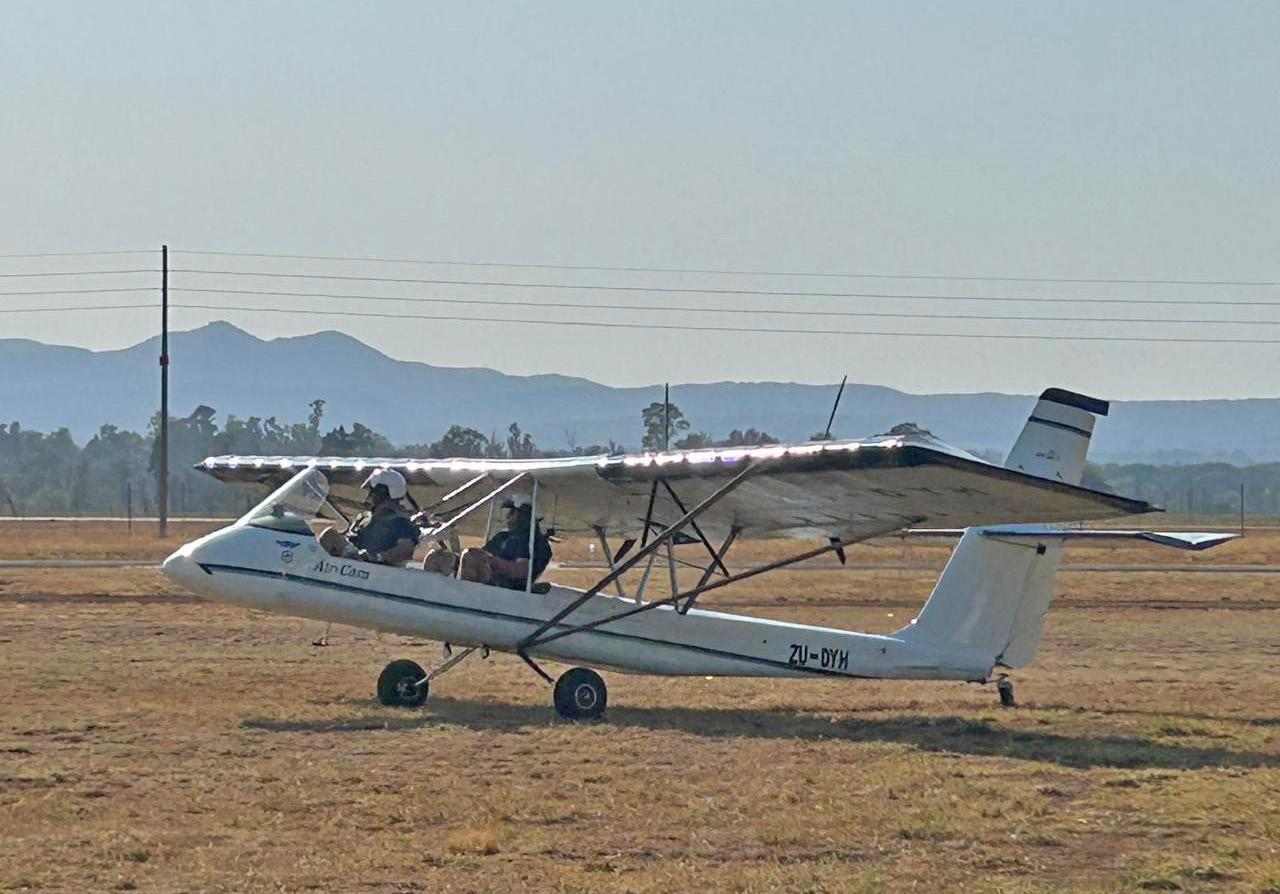
Belinda from LSA Covers measures Peter How’s Thatcher CX4.

Nigel and Kulani in their rickety tower were indispensable.

Following a refreshing shower in the spotless ablution facility, I spent quality time catching up with friends around the braai that evening.
The following morning I was woken before 06h00 by the sound of the first aircraft flying overhead. Soon the airfield was a hive of activity with planes arriving thick and fast, amongst which was my own chariot, ZU-MJB.
The day’s activities got off to a great start with an Air Nav Rally which Tarryn and Iaan Myburgh had organised. Our take off time was scheduled for 10h16 which afforded my navigator and wonderful husband Stuart, time to plot the course.
We took off amidst a cacophony of endless radio calls. Having heard all the chatter, a random pilot on his way to FALA developed a bout of FOMO and requested a fly-past which Nigel emphatically denied.
As it is, I had to dodge planes left right and centre and was pleased when we finally were in the clear to the north of the field. The course was challenging but it was good to get back in the


proverbial saddle. All girl team Adrienne Visser and Tarryn Myburgh took home the trophyStuart and I unfortunately just missed out on a podium finish.
By midday the ambient temperature was in the deep thirties and there were spots on the taxiway where the tarmac was melting into puddles of black goo.
A soft serve machine helped to cool things down and the hangar proved to be a great respite from the relentless sun.
Neil and some of the crew from Sling had organised a Cleco contest which was styled on the one in Oshkosh, which kept the folks entertained until the afternoon activities resumed. Hans de Beer completed it in a whopping 33.26 seconds, an amazing accomplishment considering the ‘world record’ stands at just 28 seconds.
The two talks offered in the air-conditioned conference venue were well received. John Comley repeated his very popular presentation on forced landings into trees and Paul Ludick spoke about Wouter Botes’ SAA Flight 406 Rietbok recovery mission.
The STOL and Spot Landing event began at 16h00 with 7 aircraft ranging from an Aircam to a Sling TSi. The winner in both the STOL Handicap and STOL Open was Sean Cronin in a Bat Hawk with a takeoff distance of just 50m.
The Spot Landing was won by Dale de Klerk in the very capable Orion Cub ZU-IVS.
Considering the hot runway, I was amazed at how well the contestants did.
That evening following a delicious meal of roast meats with all the trimmings, President of the EAA, Paul Lastrucci kicked off the muchanticipated award ceremony:
• Best Vintage Aircraft – Ethan Levin, Cessna 140 ZS-TCA
• Best Restoration – Greg Rooken-Smith, Decathlon ZS-MHV
• Best LSA – Scott Williams (all the way from Himeville), Bearhawk ZU-ISP
• Best Wood Aircraft – Mike Davis & Tony van den Heuwel, Osprey GP4
• Best Homebuilt Aircraft – Etienne Doman, Sling LSA ZU-SBK
• Longest Distance Flown to Event – Peter How Gariep Dam 303NM in his beautiful Thatcher CX4 ZU-BHX.
The well organised event proved to be a resounding success; Nigel recorded a total of 163 movements on Saturday and I counted 70 aeries over the 2 days. I am told that this is a fraction of the turnout in the event’s heyday. However I remain optimistic that General Aviation is on the rise - perhaps there is an opportunity to revive Margate as a possible venue. Only time will tell.

MARKET LEADING ENGINE and avionics upgrade company Blackhawk has announced its XP67A Engine+ Upgrade with Collins Pro Line avionics will be available for the King Air 360.
“This certification brings significant value to King Air 360 owners and operators, offering a powerful and efficient engine upgrade option,” said Edwin Black, President of Blackhawk Aerospace. “
The PT6A-67A engine delivers 1,050 SHP to altitude, significantly outperforming the baseline stock engines, which were mission optimized, but start losing power at lower altitudes. Paired with MT 5-blade composite propeller, the upgrade transforms the King Air 360 into a highperformance, fuel-efficient aircraft, reducing operational costs and increasing longevity.
Integrated with the Pro Line Fusion avionics system, the XP67A Engine+ Upgrade enhances the capabilities and market value of these
aircraft. This certification effort expands eligibility for over 300 recently delivered aircraft to fly with Pratt & Whitney’s PT6A-67A engines and the latest and greatest Pro Line Fusion avionics system from Collins.”
The Collins Aerospace Pro Line Fusion avionics system provides an advanced user interface with high-resolution touchscreen displays, Synthetic Vision System (SVS), and next-generation flight management and communication tools, further enhancing safety and situational awareness. Specifically, the upgrade to the Pro Line Fusion avionics system adds new features such as Datalink Option enabling CPDLC (FANS1/A+ Domestic & ATNB1), Privacy ICAO Address (PIA), integration with the Blackhawk XP67A Engine+ Upgrade, and the ability to add all factory options in the aftermarket. Collins Aerospace and Pratt & Whitney are RTX businesses.
j


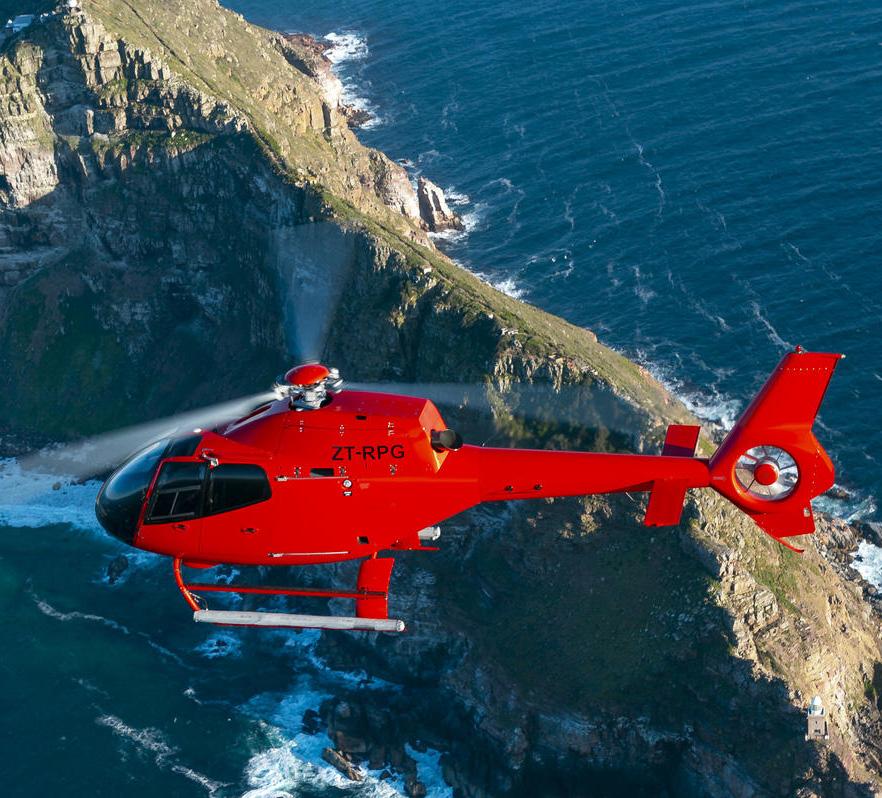

With surveillance and crime-fighting equipment vital to operations, our versatile range of helicopters perform a multitude of critical missions. Supporting law enforcement teams, who in turn support communities, Airbus proudly delivers cutting edge flight technologies that help keep the world a safer place.
Laura McDermid
Sling Aircraft was awarded the coveted August Raspet award at EAA AirVenture in Oshkosh this year. The award is given annually to a business or person that has made an outstanding contribution to aircraft design.
Where else in the world are the views out of the cockpit so magnificent!


HIGHLY REGARDED for their durability, fuel efficiency and excellent performance, Slings are the perfect light sport aircraft enjoyed by beginners and experienced pilots alike.
I have always been a fan of the brand and have followed their evolution with great interest. Visionaries Mike Blyth and James Pitman built their company based on a common love of adventure and aviation.
The Sling 2 was catapulted into the limelight when the dynamic duo flew a prototype around the world, proving the aircraft’s capability. Since those early days, Sling Aircraft has expanded its lineup, continuing to design and manufacture high quality aircraft including the four-seat Sling 4, Sling TSi, and the Sling High Wing.
Part of the resounding success of Sling has been the incorporation of the very capable Rotax engines. The most recent Sling TSis have capitalised on Rotax’s liquid cooling and fuel injection to enhance performance in varying conditions and altitudes.
The reliability and low maintenance of these engines supports Sling’s emphasis on creating aircraft that are affordable to operate and maintain.
I have been keen on flying a Sling for years and finally got the opportunity whilst recently in Cape Town. I met Etienne Bekker, owner of Stick N Throttle Aviation, at Oshkosh this year, and was immediately impressed by his passion for aviation and love of Slings.
No stranger to aviation, Etienne flew for SAA for twenty years and was a Training Captain when the company started going pear-shaped in 2006. As the saying goes, one man’s loss is another man’s gain, and Etienne spent the past 17 years in Dubai flying for Emirates as a B777 captain. He retired from the airline industry this year, returning to South Africa where he and wife Erna made Melkbosstrand in Cape Town their home.
Whilst in the UAE, Etienne hangared his own aeries, a Tiger Moth and a Piper Arrow, at Morningstar, north of Cape Town next to the N7. The airfield is currently home to 350 aircraft and is at maximum capacity. Expansion plans are afoot which will hopefully accommodate the ever-growing waiting list.
In 2019, Etienne and Erna began a flight school from Morningstar with one Sling 2. Their son, Grade III instructor Don Bekker, ran operations whilst Etienne was away with a goal to expand the fleet and offer licenses ranging from a PPL through to ATPL.
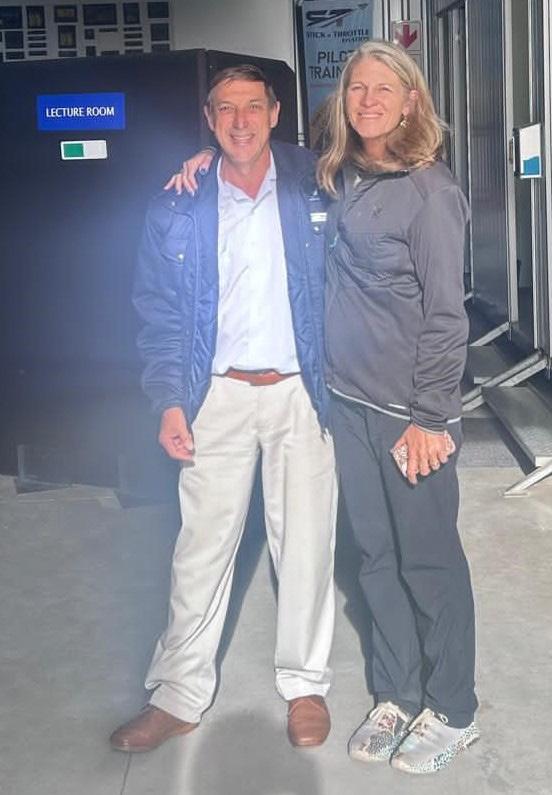

As if starting a new business isn’t stressful enough, life threw a spanner in the works the following year when all ‘non-essential’ businesses were forced to close their doors. Not one to be deterred, the interruption spurred Don and Etienne to create an online ground school which they presented on Zoom, which subsequently became a permanent feature of the school. One of the key benefits of their online training is that once a student enrolls for the lectures, they have lifetime access and are able to revisit a lesson at any time.
Fast forward four years and the school now has three sling 2s, the most recent acquisition ZUFTM was recently flown from Pretoria by Don.
A Piper Warrior and two privately owned Sling 4 TSis are available for dual instruction and It was on one of these Slings, ZU-STR, that we did my conversion.
Until recently, Etienne was also one of the only instructors in the Western Cape who was qualified to test the practical and written radio exam.
The school has two fulltime grade II and three grade III instructors who instruct a minimum of 40 hours a month. There are 25 active students at any given time, the majority of whom are PPL students.
The school also boasts a Red Bird simulator, an essential piece of equipment, especially in a province where the weather is so unpredictable!
Stuart McDermid going through the checklist with instructor Don Bekker.

Memorabilia in the hangar include seats from the 747 that flew over Ellis Park during the 1995 Rugby World Cup and a very old simulator.

Briefing on Saturday began with coffee and rusks followed by a tour of the facility. We were joined by Craig Mincher, a proud owner of a new Sling 4 TSi fitted with a Rotax 916is engine, an Airmaster Variable Pitch (VP) hydraulic prop and a ballistic chute. The aircraft is still in the process of being assembled at FATA, and will hopefully be ready before the end of the year.
Don explained the differences between the Slings and made special reference to the variance in the performance between the various Rotax engines.
Star One, the aerie that we would be flying, has a Rotax 915is turbo engine with an electric VP propellor, neither of which we were familiar with.
By the time briefing was over, the southeasterly wind had announced itself, and we made arrangements to fly on Monday morning.


ABOVE: New acquisition ZU-FTM outside the school.
BELOW: Don Bekker and student in the Sling 2 ZU-FOH at picturesque Morningstar Airfield.

On Monday, my husband Stuart opted to fly first. I hopped into the spacious back seat of Star One and could tell that the aircraft is much loved by owners Eran Feinstein and partner Ingrid, who keep the aircraft in immaculate condition.
As if the roomy cockpit wasn’t impressive enough, I was blown away by the extras such as the sun visors and air conditioner, not to mention the fact that the back seats can be folded flat, making room for two mountain bikes plus luggage. In the end it was the cup-holders that sold it for me, for what is an early morning flight without coffee?
Laminated charts were on hand to assist with the pre-flight and takeoff procedures; all of which are also programmed into the EFIS.
Stuart took off on Runway 20, by which time the south easterly wind was gusting 15 knots. We flew to the general flying area where he executed a few steep turns and stalls and by the time we headed back to Morningstar the wind had turned due east and had picked up significantly. Although I felt the turbulence, the aircraft handled the conditions superbly, even when it was tossed around by the wind shear over the eucalyptus trees on final approach.
Although I was given the option to fly, I noticed Don relax when I opted to rather return on Wednesday.
The flying gods took pity on me and Wednesday turned out to be one of the best days that the Western Cape had seen for months.
Our own aerie, an Alpi Pioneer 300, has a simple six pack, thus finding my way around the glass cockpit took some getting used to. Star One is equipped with a Garmin G3x Touch, a Garmin G5, and Garmin GMC 507 auto pilot. I begrudgingly found the ADS-B function to be useful despite my misgivings about CAA’s most recent demands.
Accustomed to the Rotax 912ULS, I found the transition to the 915is turbo to be the most

challenging aspect of flying the plane. Combined with the electric VP 3-bladed Elcoprop, the 800 foot climb to circuit height happened in a blink of an eye, and Don kept on having to remind me to slow down.
Once comfortable with managing the speed, I found the aircraft a dream to fly. She was responsive and solid and docile in the stalls.
The circuit direction had changed to 02 on our return, which didn’t really matter considering the 10 knot easterly breeze. My familiarity with the runways at Eagles Creek and Jack Taylor stood me in good stead, and the Sling 4 gently kissed the tarmac on the skinny 600m long runway.
The school recently went paperless and within 15 minutes Don had signed me out and had submitted the paperwork to the CAA.
In my estimation Morningstar, Stick N Throttle and Sling TSis are all rising stars. A comment Etienne’s made summed up my experience ‘Ours is not a flight school, it’s a family’.
For more info contact Etienne Bekker: +97 55 787 8905
Coffee and rusks before briefing. j


Located in South Africa’s Safari hub of Hoedspruit, Safari Moon is a boutique base from which to discover the wonders of South Africa’s Lowveld region. Explore a range of nearby attractions from the famed Kruger National park to the scenic Panorama Route, or simply chose to relax and unwind in nature, making the most of your private piece of Wildlife Estate wilderness.
Photos Trevor Cohen. Text Guy Leitch
The 2024 Wonderboom Airshow was known as the Hotazel airshow because the day was scorching hot – and the displays matched.
THE SAAF WERE A HIGHLIGHT of the show – thanks to the rare participation of two separate Gripens flown by Lt Col Eddie Secco call sign ‘Cipher’.
The air show provided an eclectic mix of aircraft types – from Airlink’s graceful Embraer E190 to a busy radio controlled Extra 300, plus skydivers, helicopters and gyros.
The 3-ship Flying Lions team opened the display flown by Arnie Menegelli , Sean Thackwray and Ellis Levin.
The Gripen flown by ‘Cipher’ was a great crowd pleaser. Interestingly a different Gripen was flown for the second display in the afternoon.
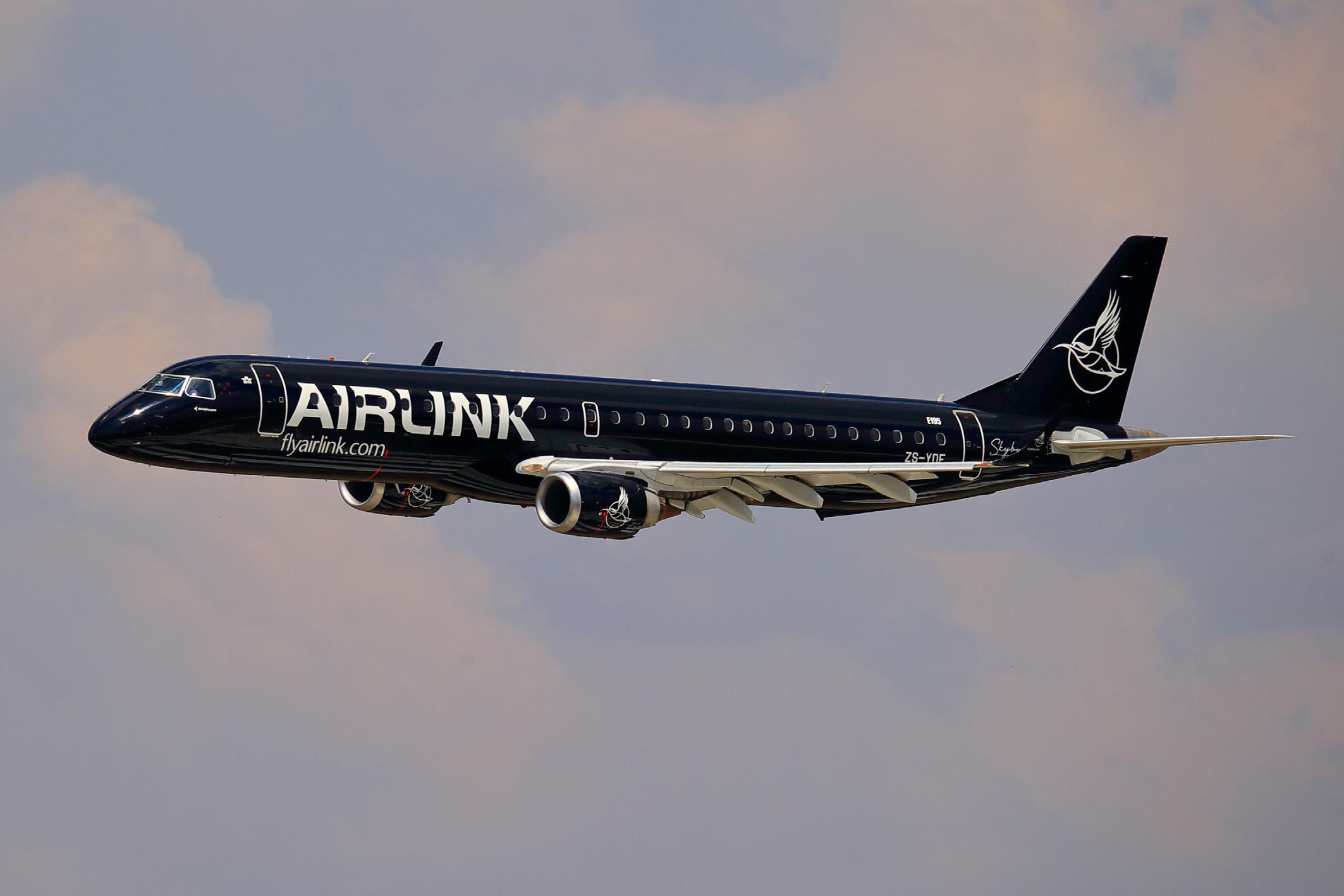

ABOVE: Much appreciated SAAF Gripen. BELOW: Paramount's Mwari was on home turf.




After the Gripen the Goodyear Eagles presented a 4-ship display, thanks to Levin family scion Sally Fleck having joined the team.
There was great excitement when it seemed a helicopter was being stolen. Normally the drunk pilot act is flown with a Piper Cub or similar, so having a Jet Ranger being thrown around was a rare spectacle, but heli supremo Juba Joubert awed all with his skills.





Cirrus had their SF50 Vision jet on static display and flew a SR22 G6 with Scully Levin flying Cirrus CEO Tony Forbes. At 78 years old, Scully must now be one of the oldest airshow performers in South Africa.
Nigel Hopkins and Jason Beamish paired up again in their Master Power red and blue Extras to present jaw dropping precision flying.
Another rare treat was the display by the Aerosud Mwari. This aircraft has a 950 hp PT6 and its good power to weight ratio was well demonstrated by Mark Berg.
Stalwart commentator Brian Emmenis of Capital Sounds was notable in his absence and commentary was provided by radio station DJ Dylan Rogers. This was generally well received but there were a few cringeworthy moments – such as Top Gun being played incessantly during both Gripen displays.
Also notable in his absence was Menno Parsons – who can normally be relied on to fill the sky with the song of the Rolls Royce Merlin in his P-51 Mustang Sally.


A welcome return was the Raptors RV team which showed they still have the ability to put of a precision 4-ship formation aerobatics display.
Airlink’s black liveried EMB-195 was flown by Jaco Henning, and despite being a regional sized airliner, if provided a great wow factor.
The Embraer was followed by another crowd thriller, being the ‘theft’ of a car and its recovery by ground-based troops supported by Henley Air’s Andre Coetzee.
Andrew Blackwood-Murray once again flew a solo display in his Extra 300, which is now in its 20th year of sponsorship by Nashua. Only the Goodyear Eagle have managed to retain longer sponsorship.
The show closed at 15.00 with the Flying Lions. Unfoirtunatley this was too early for their beautiful evening show, but the rumble of the radials is a great way to end the show. Against the most stunning clouded backdrop, their display was simply mesmerizing!
Heinz van Staden passed away in 2022, Willie Algera and Stephan Bronkhorst bought the company. This was a relief to the many customers of Skytech who have come to rely on the company’s innovative and high quality helicopter and fixed wing ground handling equipment.
Based in Kempton Park, near OR Tambo International Airport, Sky Tech has developed home-grown solutions to the demanding problems of safely moving very valuable aircraft.
Using the highest quality materials and engineering techniques, Sky Tech has saved helicopter and fixed wing owners and operators from having to import expensive and poorly supported ground handling equipment from Europe and the USA. By using a local company, aircraft operators are assured of fast, convenient and good value product support.
Willie Algera and Stephan Bronkhorst are now the key figures driving this vital engineering business with its passion for innovation and excellence. Their experience enables them to devise custom solutions for every specific aircraft, avoiding the risks of having to use generic equipment which may damage expensive components such as aerials and externally mounted surveillance and communication equipment.
Operating under the banner “Where innovation meets durability in helicopter and aircraft ground handling equipment’, Sky-Tech’s mission is to deliver top-tier helicopter and fixed wing aircraft jacks, tow bars, engine stands and helicopter handling wheels that enhance operational efficiency and safety.
Sky-Tech’s blend of experienced craftsmanship, advanced manufacturing processes, and rigorous testing ensures that its products are second to none.
For more information visit: WWW.SKY-TECH.CO.ZA.
Contact Willie on 083 374 2426, email: willie@sky-tech.co.za or Stephan on 083 442 4540, email: stephan@sky-tech.co.za j















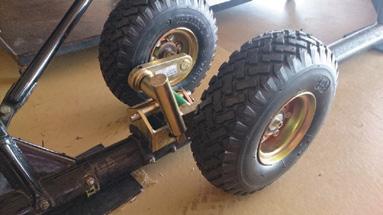









2 November EAA auditorium Neil Bowden E-mail: airadventuresa@gmail.com

20-24 November Djerba Zarzis Airport
IADE Tunisia E-mail: admin@iadeorganiser.com
20-22 May 2025 Geneva
Contact: info@ebace.aero +32 2 318 2800


22-24 May 2025 Bona Bona
David le Roux:david@pilotinsure.co.za cell: 073 338 5200


21-27 July 2025 Oshkosh
Neil Bowden: 084 674 5674 info@airadventure.co.za



Hugh Pryor - How high’s a Hercules?
Managing Editor Guy Leitch guy@flightcommag.com
Advertising Sales Howard Long sales@saflyermag.co.za 076 499 6358
Layout & Design
Patrick Tillman: Imagenuity cc
Contributors
John Bassi
Laura McDermid
Darren Olivier
Jeffery Kempson
(0)81 039 0595
(0)15 793 0708
Laura Mcdermid - The Arms Dealer
Airline CEO Insights:Burning Issues
Jeffery Kempson - American Recce
News - IATA offers digital currencies
News - Denel’s new Single Rotor UAV
News - Airline Data Standards
Jannie Matthysen - Tell Me Why Aviation Consultants Directory
Superior Pilot Services: Flight School Directory
Merchant West Charter Directory
Skysource AMO Listing
Backpage Directory AME Doctors Listing News - Starlink Qatar



ACROSS AFRICA we see countless examples of failures to provide essential aviation safety and security services.
Perhaps the most laughable is the regular failure of the power supply to the baggage X-Ray scanners. Security checkpoint officers have been seen to be diligently pushing bags through the unpowered scanners with a stick.
There is increasing evidence that what passes for airport security checks is in fact just an elaborate theatrical performance – more designed to reassure passengers than deter any hijacker or terrorist bomb.
The whole painful drama of airport security checks began nearly fifty four years ago, when on 10 November 1972, three innovative crooks hijacked a Southern Airways DC-9 with 31 passengers and 3 crew. The drama started in Birmingham, Alabama and the novelty of dealing with the problem meant that it continued for 30 hours and 6,400 km, only ending the next evening in Havana, Cuba. The hijackers’ threat to crash the aircraft into a nuclear reactor led directly to the requirement that airline passengers be physically screened, with effect from 5 January 1973.
was that a bomb was placed in the hold by a baggage handler, or someone who had airside access.
For a while EgyptAir flight MS804 was thought to have been a bombing, but that is now generally accepted to have suffered a pilot’s iPad induced cockpit fire.
Pilot suicides are the biggest problem – and airport security checks can’t fix that. Malaysia’s Boeing 777 MH 370 is now generally accepted to be a suicide. As was the Mozambican Airlines Embraer 190 which crashed in Namibia and the Germanwings A320 which dived into the Alps.
The need for a theatrical performance about security is that airliners are high profile targets for terrorists –and politicians. These tragedies led to calls from politicians demanding tighter airport security – and so a big show is put on.
Since then there have been amazingly few successful hijackings or terrorist attacks compared to the number of flights flown. Other than one event in the Middle East, there have been no deaths or injuries from terrorists in airliners since the 911 attacks 23 years ago. The event that we know for sure was terrorism was the bombing of Metrojet Flight 9268, an A321 flying from Sharm el-Sheikh to St Petersburg. The finding
One of the weaknesses of the security inflicted on passengers is that they are – perhaps surprisingly –largely toothless. The ban on liquids, aerosol and gasses (LAGs) introduced in response to the 2006 plots, is a case in point. If security staff find illicit liquids that a passenger has not presented, they confiscate the containers, but still allow the passenger to fly. And despite the mild consequences, nobody has been caught trying to get liquids on board to make a bomb in over ten years.

1994 was a bad year for South
was just beginning to show signs of digging itself out of the mire and some of the old money which had fled the country when the Russians arrived was trickling back. One or two of the stunning multi-storey Baroque palaces in the Wadi Douan sported new paint and primitive scaffolding announced that repairs were being effected to these historic structures, some of them over six hundred years old.
A fragile breeze of optimism pervaded the scorching canyons of the Hadhramaut and suddenly the old brick-makers were back in business as the demand for their sun-dried products increased.
North and South, creating at last the Greater Yemen so often attempted before but never achieved. The fact that half the South Yemeni Army would now be based in the North, surrounded by Northern Military, escaped the Southern leaders’ notice until it was much too late. A contained skirmish around the encircled Southern forces billeted in North Yemen heralded the beginning of the North’s drive to take over the whole of South Yemen.
Then rumblings of war began to issue from the North. The population of North Yemen was around fifteen million and there was a serious land hunger in the ancient villages which clung precariously to the rugged crags which made up so much of North Yemen’s geography. The population of South Yemen, however, was only two and a half million, although the land area was many times greater than that of the North. Inevitably the eyes of the Northerners were attracted to the vast open spaces to the South, particularly now that the Russian Bear had withdrawn his protective military mantle.
The North diverted international scrutiny from its hegemonous intentions by proposing a Union between
We were in South Yemen at the time and the Canadian oil company to whom I was contracted, decided to evacuate all non-essential personnel. Our “expat” presence effectively went from around twelve hundred down to about one hundred and twenty. Insurance premiums provided the primary motivation in getting the high-earners out before the war got under way. To give you some idea, the premium for the aircraft rose to two percent of total hull value per week.
Of course, among the evacuees were all our Senior Staff and we were left in the very capable hands of an enormous Texan called “Big Foot”, who was actually a Pipeline Supervisor.
If your salary rose above the $14,000-a-month level with this company, you moved into the “Senior Compound”, down at the Central Processing Facility,
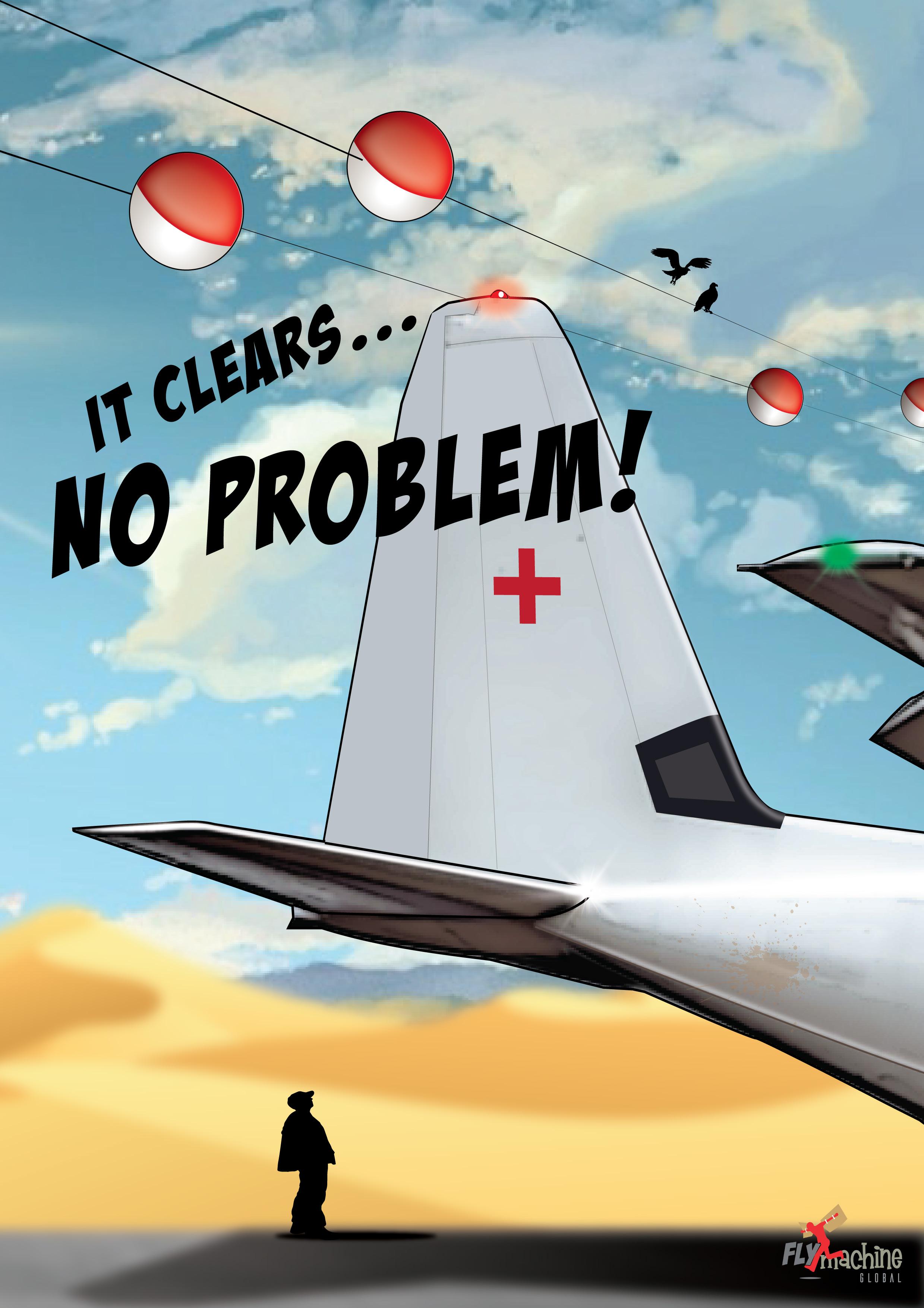
where the security was a bit tighter and the containers full of essential supplies were kept for the siege scenario.
When the “Non-Essentials” left, Big Foot decided that the first thing to do was to make an inventory of all the supplies we had available, to see how long we could survive, cut off as we were by the war. One of the containers in the senior compound had about six locks on it and naturally became the focal point of our attentions. We finally cropped the padlocks off it and opened the doors.....Wall-to-wall Chivas Regal! We couldn’t believe our luck!
Well now, of course, nobody wanted to go home!
Luckily siege mentality governed our consumption to a certain extent, otherwise I would still be in the clinic, but, having said that, a few entertaining evenings were definitely had by all. The Canadians had sent out a French-Canadian expert to design and construct an airstrip suitable for the operation of Hercules Transport Aircraft which would provide our escape route in the event of a serious breakdown in security. He turned out to be an arrogant little fellow who was actually proud of the fact that he was the only inhabitant of the senior compound. I got the feeling that this unfortunate engineer was sent as a kind of sop to us who had stayed behind, to assuage the evacuees’ slight twinges of guilt as they scuttled away! Anyway, he was happy, since he was now the only person left on site who qualified financially for the Senior Compound. In fact even he couldn’t believe the generosity with which the company had smothered someone of his limited experience with money..... and when he asked me for advice one evening, neither could I!
“Well I was wondering if you could tell me how high a Hercules is.”
“How high?” I looked up at him in some surprise and then jokingly added, “Do you mean when it’s on the ground, or when it’s in the air.?” “Oh I’m talking about when it’s on the ground of course.” he replied, having missed my meagre attempt to bring some levity into the conversation. “Well, to be honest I’d have to look in the book.” I said,"but I suppose it must be up around forty feet to the top of the tail fin...somewhere around there, wouldn’t you say?” But this was obviously not accurate enough for our aerodrome expert. A worried look came over his face. Maybe these Frog-Canadians aren’t allowed to use feet. “Sorry,” I corrected, “I mean about twelve metres.” “Is it urgent?” I enquired.
“What got up his backside?”
“Well they want to get started on the pylons tomorrow morning, so I would really need that information first thing if you could get it to me.” Now our boffin was putting the pressure on. I suddenly got the feeling that any delay to the construction of the runway was being subtlely laid at my doorstep. “I’ll certainly see what I can do for you.” I replied “Although I can’t make any promises. What are the pylons for, anyway?”
“Excuse me, Mr. Pryor,” he started, as we relaxed over a dram of Mr. Chivas’s Regal, “Could I possibly pick your brains for a moment.”
“Of course.” I said, the relaxing influence of the Whisky encouraging me to be friendly with the guy, although I had not in fact had the pleasure of meeting him formally as yet. “If you can find any to pick. How can I help you.?”
“Oh, they’re just to carry the three-phase electricity cables over the top of the runway. It is significantly cheaper to take them over the top than to route them around the end of the runway. We thought of putting a trench across under the airfield, but we decided that it would probably not be appreciated by the crews having so much voltage running right under where the ‘planes were taking off. You know how sensitive these people can be.” For some seconds I thought I must have misheard him, then it suddenly dawned on me that this character was actually for real! He was intending to hang three-phase cables right across the middle of the flaming (very possibly, if he was allowed to go ahead!) runway! “No! No! No!” I exclaimed in disbelief.”You can’t do that!”
“Mr. Pryor,” he said, adopting a school-masterly severity, “This company is not a bottomless pit when it
comes to finance, you know. It is my responsibility to seek the cheaper option whenever possible. We could probably stretch to some of those fluorescent marker balls to make the wires more visible if you absolutely insist, but that’s about as far as they’d be prepared to go, I’m afraid”
“Then you won’t be getting many visitors at your new airport.” I said. “Nobody in his right mind would take-off or land a large aircraft under power-lines, except in a dire emergency. I have taken off from a road under some high-tension cables, but that was in a single-engined ten-seater with no passengers on board. No...I’m afraid you’re going to have to go for the expensive way this time, if you want anybody to use your airstrip, of course.” He visibly winced at the use of the word “Airstrip”. It somehow seemed to reduce him to the status of Human Being. Anyone could build an “airstrip”. “Airports” demanded the services of a “Civil Engineer” and $500-a-day was the least you could pay to get one of those elite

persons to come and work in a war zone. In fact he was very non-plussed by my attitude and expressed his displeasure by storming off to bed.
“What got up his backside?” enquired one of the Americans.
nobody wanted to go home!
“Oh, I told him he couldn’t put the power lines across the new runway. I think I just ruined his budget.” “I knew the guy wasn’t for real when I offered him a Whisky and he said he didn’t touch the stuff.” remarked the American and we went back to discussing the progress of the war.
The runway was completed on schedule and the power lines were re-routed around the Southern end of the strip, We even had one visit from a Hercules. But by this time our “Civil Engineer” had left for Canada. Maybe he’s still looking for an airport where they will let him put some power lines over the runway.
Church Belinda Valhalla 079 636 9860 churchbs@live.com
Du Plessis Alexander Athlone Park 031 904 7460 dex.duplessis@intercare.co.za
Erasmus Philip Benoni 011 849 6512 pdceras-ass@mweb.co.za
Feinberg Rodney Lyndhurst 011 882 6010 rodneyfeinberg@gmail.com
Govender Deena Umhlanga Rocks 031 566 2066/7 deena@drdg.co.za
Head Brandon Sandton 010 448 0900 reception@drbradonhead.joburg
Maneli Lumka Sandton 083 471 2051 lumka@doyioccuhealth.co.za
Toerien Hendrik White River, Nelspruit 013 751 3848 hctoerien@viamediswitch.co.za
Air Wing could not fulfil a mission, they would charter Air Kenya. As a result I had the great fortune of discovering remote places like Garissa, Wajir, El Wak and Mandera.
El Wak was very close to the Somali Border and was famous for its fort which closely resembled Fort Zinderneuf, a fictional fort in the Sahara desert out of the novel Beau Geste. Published by P.C. Wren in 1924, it tells the story of three brothers who join the French Foreign Legion after a valuable family heirloom is stolen.
Whenever I flew to El Wak, I couldn’t help but think of Snoopy’s Legionnaire alter ego “Beau” Snoopy, the novel’s tragic hero, attempting yet another siege of Fort Zinderneuf.
Pilots at the time had a saying about El Wak which went like this: If you were only given three months to live, move to El Wak and it would seem like forever.
One of the many really interesting people that I met in the short time that I’d been flying with Air Kenya was Roger Sylvester. Roger was responsible for securing all the charters to the Ol Pejeta Ranch which had

recently been purchased by Adnan Khashoggi, the Saudi arms dealer and businessman, which marked a significant chapter in the property’s transformation.
Located in Laikipia County, near Nanyuki, on the foothills of Mount Kenya, Ol Pejeta Ranch covered around 90,000 acres. Khashoggi was one of the richest men in the world, with properties around the globe and the acquisition of Ol Pejeta was part of his growing portfolio.
From its early days of cattle ranching, Ol Pejeta evolved to serve multiple purposes, becoming a private playground for Khashoggi and his wealthy circle.


Khashoggi’s ownership coincided with a surge in global interest in Kenya as a premier safari destination, opening the door to the allure and romance of highend East African luxury safaris. We would often fly Khashoggi from Wilson Airport to his ranch where we would spend the day ‘hanging out’ whilst Khashoggi dealt with his business affairs.
What I learned during my tenure flying charters is that it didn’t matter if a person was ultra-rich and commanded an empire. When they boarded that plane, they relinquished control to those in charge, winding their egos in a few notches, as the altitude reminded them that, up there, power meant trust—not in wealth or status, but in the hands guiding them through the sky. Being in such close confines at 10,000 feet brought out a different side to most of my wealthy clients. They were courteous, friendly and made me feel very comfortable in their presence.
When I’d spend the day at Ol Pejeta Ranch, I would be invited to join the Khashoggi family for lunch. The meals were a feast of traditional Arabic dishes, including warm flatbreads with hummus, fresh tabbouleh, grilled halloumi, and perfectly spiced kofta. To complement this delicious spread I was always offered a glass of exquisite wine like Chateau Margaux or Châteauneuf-du-Pape.
Sadly there was no drinking for us pilots on duty, but on occasion I would find a bottle waiting for me in my aircraft to be enjoyed later. And so my first taste of Château Margaux was paired with a humble dinner of boiled eggs—the only food I had in my fridge at the time.
The Ol Pejeta airstrip sat at an elevation of 6,300 feet, composed entirely of black cotton soil—a tricky surface, especially during the rainy season. Once wet, it became as slick as ice. To keep the aircraft from sliding off the runway, we avoided using the brakes and quickly adapted to the challenge, becoming seasoned black cotton soil pilots in the process.
There was one particularly wet day when the runway was deemed too dangerous and I was grounded for the night. I hadn’t packed any overnight gear, so George—Khashoggi’s right-hand man and the ranch manager—kindly offered me a place to stay at the residence. Not wanting to appear ungrateful, I asked if he could instead arrange for me to be driven to Nanyuki, where my brother Danny’s in-laws lived. George quickly organized a driver, and before long, we were slipping and sliding our way through the mud for a bumpy 30-minute ride
Danny’s in-laws, Jane and Digby Tatham-Warter considered me part of the family and I had in turn ‘adopted’ them as my own in-laws.
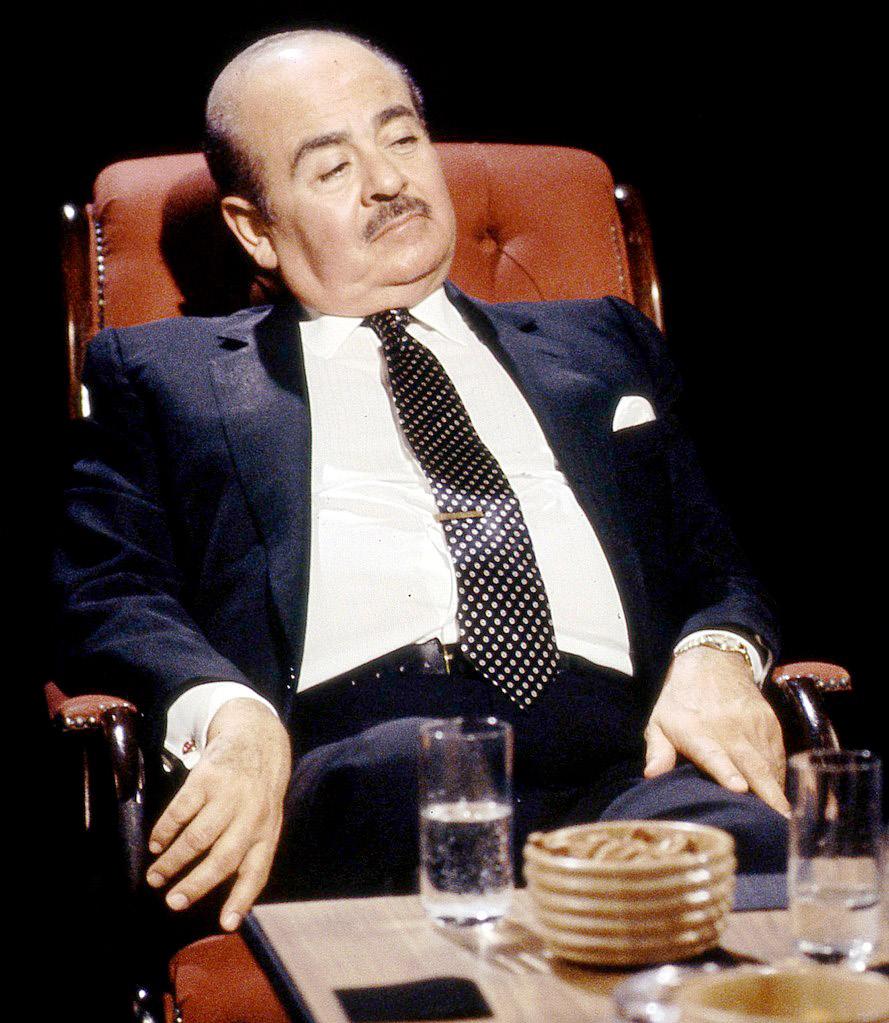

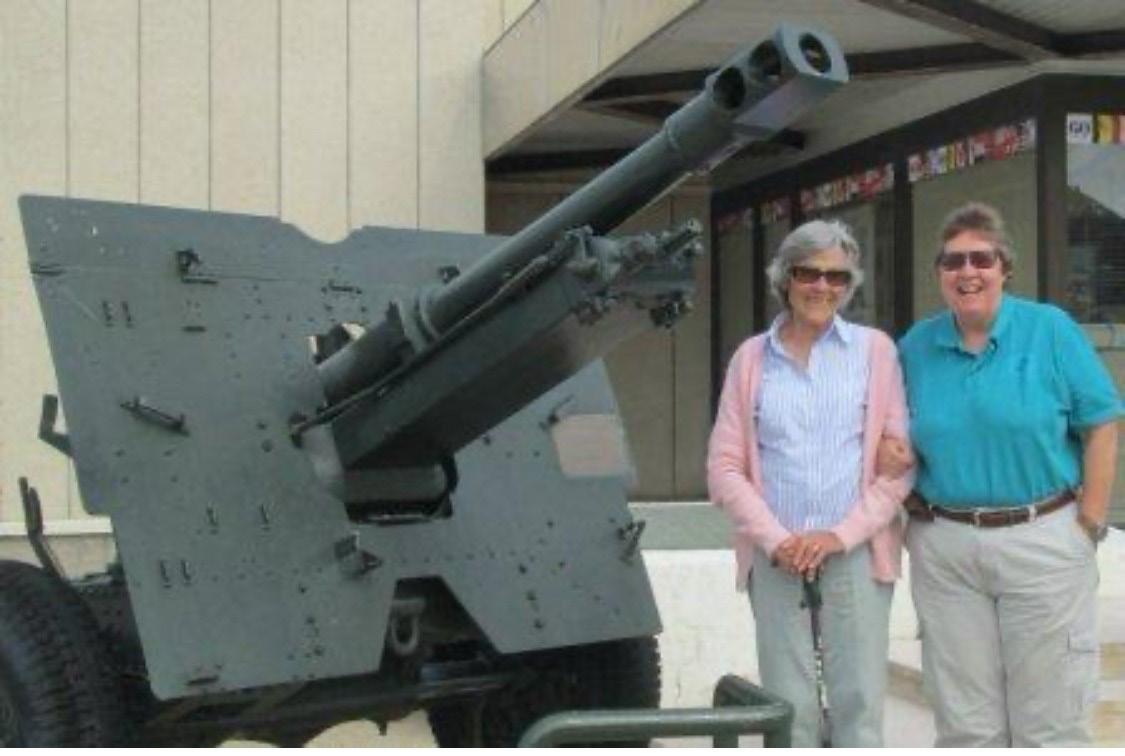
Major Allison Digby Tatham-Warter was a British officer known for his unconventional bravery during the Battle of Arnhem in World War II where he was awarded the Distinguished Service Order.
Digby was a tad eccentric and was known for wearing a bowler hat and carrying an umbrella into battle, which inspired the character in the film ‘A Bridge Too Far’, an epic historical war film directed by Richard Attenborough. During the Battle of Arnhem, Digby was injured by shrapnel, but continued to fight until they had run out of ammunition, following which they were captured.
My clothes were streaked with mud, and my typically wild bush pig curls were plastered to my head. I apologized for looking as though I’d been dragged through the bush backwards, but Jane just smiled, handed me a glass of wine, and offered me a bright pink kaftan to change into. The evening unfolded with good food, wine, laughter, and effortless conversation.
Digby was sent to St Elizabeth’s Hospital, where assisted by the Dutch Resistance, he escaped out of a window with his second-in-command, Captain Tony Frank.
Jane greeted me warmly, thrilled that I had “perfectly timed my arrival” as she was in the middle of preparing for a dinner party. Among the guests was Colonel Herbert Jones, the Commanding Officer of the 2nd Battalion, Parachute Regiment.
As it transpired, I never saw Colonel Herbert Jones again as he was killed in the Falklands war a few months later and was awarded the Victoria Cross posthumously.
The following morning we awoke to brilliant blue skies and George sent the driver to collect me. By the time we got back to the Ol Pejeta Ranch, the sun had dried the airstrip out and Khashoggi and I flew back to Wilson without any incident.
At the recent Airlines Association of
annual conference, Guy Leitch took the opportunity to canvass the various regional airline C-suite executives about what the burning issues are that their particular airlines face.
THE CURRENT CEO of Air Zimbabwe, Edmund Makona, likes to quote a previous IATA Director General, Tony Tyler, as saying that the natural state of the airline industry is one of crisis, interrupted by brief moments of stability and calmness. Being in a perpetual state of crisis implies that there must be burning issues.
Makona references IATA’s finding that collectively, African airlines are making just 90 US cents profit per ticket sold. And importantly, this 90 cents is almost entirely being made by just two airlines – Ethiopian and FlySafair. This means that almost every other airline is making losses. So for Makona the burning issues remain the excessive charges, taxes and levies imposed on African airlines.
“The challenge is that we must be as efficient as other companies if we are to cover the costs of aircraft lease, maintenance and fuel. The burning issue then is that we must become competitive, which means that we are going to have to learn to be innovative, and in particular, to share routes and resources. In so doing, we can share costs and technology, so we don’t have to be one airline trying to cover all the routes everywhere.”
When airlines fail because they are not sustainable, Makona says, “All the benefits of aviation are lost to the broader economy. While there are other modes of transportation, aviation is the one that most quickly creates [essential commerce and transport] links to other countries.
Makona concludes, “We need to fix ourselves and not be the victims of things like the Cape Town Convention. There’s an old saying that when an egg is broken from the outside life dies, but when an egg is broken from the inside, that’s when life starts.”
For FlySafair CEO Elmar, his burning issue is, “I would like to see a considered attempt to reduce the amount of regulation. We need deregulation so that the costs can come down, especially amongst the providers of fuel and services. We put too little trust in the free market to sort things out.”

Conradie says, “Success comes from embracing competition to provide efficiencies and a better product. There are things that we can control, and things that we cannot control in terms of the markets we serve.’
For Conradie a specific burning issue is that, “There is a shortage of [seat supply] capacity. This may seem strange to say after the surplus capacity of last year. But this lack of capacity is easy to fix. As an industry, I think that there is much that we can do. They are not difficult things, but very fundamental things that we can achieve in each service provider.”
Conradie quotes the example of the famous British cycling team coach, Dave Brailsford, who developed the practice of achieving marginal gains to make his team champions. Conradie says that Brailsford’s philosophy is, “You can use small improvements to get 1 percent better every day and find success.”
Brailsford called it the aggregate of marginal gains. He broke down cycling into its component parts and said that if you can improve each of those components by just 1% you will transform the performance.
Applying the 1% principle, Conradie says, “For example, a burning issue would be to improve regulator performance so that we can get Foreign Operator Permits (FOPs) approved 1% faster or Certificate of
Air Worthiness (CofA), approved 1% faster. And if we can get people through immigration just 1% faster, then the gains that we will see as an industry will be way more than that. So my plea is for everyone to just get back to doing the fundamentals better.”
Conradie concludes by saying, “We need to sit down with the regulators and put the burning issues on the table and get them to work with us, rather than against us. We need to workshop the issue so we can prioritise the key issues. And then hold them accountable to these issues.”

In the late 1980’s I went to America to have a look around with a view to possible relocation, and while there acquire an FAA ATP licence.
APART FROM MY RETURN ticket to the US, I also bought a Delta Pass in Johannesburg which allowed non-US passport holders to fly within the continental USA for a month without further payment.
Arriving in New York, I spent a couple of days acclimatising then flew on the Delta Pass to Miami. I took a taxi to Sunny Isles, north of Miami, and reasonably close to Opa Locka airfield.
The driver asked me where I was from. “South Africa,” I replied.
He laughed and said, “That President Botha in your country is one tough mother. He whipped the Cubans, and now he’s keeping everyone else in line too. He should be here in Florida running Dade County.”I booked into a budget, but comfortable, beachside hotel.

Next day I took a cab to Tursair at Opa Locka airfield, a drab grey place surrounded by low cost houses.
There I took the intense four day lectures – and passed the exam. This was followed by a further intense four one-and-a-half-hour IF sessions in a well-used Beechcraft Travel Air, which is like a four-seat Baron with two 180 HP engines. It was a responsive machine with just two on board and adequate for twin engine training as the lightly loaded Travel Air had no problem on one at sea level.
Every day I donned the IF hood climbing through 300 feet, and we headed for a training airfield in the Everglades. Here, with one engine at zero thrust, I performed numerous single engine ILS approaches, before pushing both throttles forward to overshoot. We also did daily VOR and ADF let downs, although the British/ South African QDR and QDM nomenclature was a complete mystery to the Americans.
This system was devised by the British for Morse code transmission. The Q stands for Question, and the next two letters are the body of the question. Thus, QDM stands for: ‘What is my Magnetic bearing to your station?’

After flying consecutive approaches for four days, I was deemed ready to be tested by an FAA designated examiner. So, on the fifth day I flew a 1,9-hour check ride with the FAA guy to nearby Fort Lauderdale for our IF approaches, which worked out fine after having to scrabble for the new instrument frequencies. We flew a simulated engine out after Takeoff, then a single engine landing along with a flapless landing, then a short takeoff and landing along with general aircraft handling abilities, including flying the appropriate entry procedures into holding patterns.
The examiner seemed surprised that I carried a high speed into the ‘pattern’ (circuit) before reducing to gear and flap speeds. I told him that South African charter pilots were often asked to keep the block speed up.
After a favourable debriefing the examiner handed me a temporary FAA ATP, to be followed by a permanent one, sent to my South African address.
In the taxi back to the hotel I regretted not asking for a junior instructor to fly me around the area in an affordable C172 so I could have a look at the Florida beaches and the mysterious Everglade training strip, to see where the hell I’d been.
I now held a coveted senior licence, and while the written exam matter applying to airliners was mostly common sense, and not as difficult as the SA written ATP, the IF flying portion had been very intense. Nothing much that I learned there would be of much use to an African bush pilot.
Two days later I took a cruise ship on a three day trip in the Bahamas.
The US dollar at that time bought R2.50, so I felt I might be able to afford a small second hand fourseat plane, and perhaps a 28 foot yacht to live on in the Bahamas. I imagined myself flying Twin Otters while dodging hurricanes and so achieving an envious lifestyle.

However, the working pilots I spoke to seemed mostly overworked and disgruntled, and many of the aircraft in commercial service had very high times and cycles.
On my second day I fell in with a jovial yachtie. He showed me over a friend’s 30 foot sloop, which looked pretty good, until he pointed out that parts of the hull were delaminating, then pointed out several other mounting deficiencies that would cost a lot to fix.
I bought him a fish dinner, and decided I couldn’t afford a yacht if I had to pay for such expensive upkeep.
Back in Florida I used my Delta Pass to visit California. I changed planes at Dallas and boarded a B757 for the leg to John Wayne airport in Los Angeles.
estate, and that she lived in nearby Diego Beach and offered me a lift to that area.
She had a car phone, and once aboard her Porsche I phoned Jane Clements, but there was no answer. I tried a couple more times, to no avail. “Well”, she suggested, “You’d better come back to my place, and try her again later.”
I had an invitation to visit Jane Clements, an attractive young ex-South African pilot flying as a co-pilot on one of the major US carriers, who had an apartment at Huntington Beach.
However, after takeoff a pretty forty-something blonde sitting one seat away heard me order a Coke from the stewardess. “Where are you from?” she asked.
“South Africa,” I replied. This piqued her interest, and we fell into conversation. She said she was in real
Anyway, she had a nice apartment, and I never got to contact or speak to Jane, but spent four memorable days with the intriguing lady. She wined and dined me and showed me the sights. Then I had to fly back to Miami for an airline interview with a US carrier that my recent instructor had arranged for me.
It seemed that some US airlines could apply for a 2-year green card waiver if they employed a foreigner who met their criteria and undertook to repatriate them if things did not workout.
When the California lady dropped me back at the airport she kissed me on the lips and said; “It’s been great knowing you. I loved your company, and by the way you’re my first, Jeff. Now, I don’t want a reprise, please don’t call or write me, and if you’re ever back in the area please don’t ring my doorbell.”
I smiled and asked; “You’re not wearing a ring, but are you married?”
She smiled. “Yes, he’s a big pro-football player away visiting his mom; he’ll be back on Thursday. He’s adequate, but immature.” Then she waved and drove away, an energetic woman and an enduring memory.
On the plane to Miami I met four South African men running out of money, who used their Delta Passes for overnight flights in lieu of accommodation until they needed to return to SA. Amusingly, they carried a thick Delta timetable which also listed what on-board movies would be showing on their various flights. They were using this as a guide to select their intermediate US destinations.
who was meant to interview me had been called to their Chicago office and wouldn’t be back for a week.
So, I took in the Miami nightlife for a couple of days. Then, while sitting in a laundromat watching my clothes spin around in the machine, I asked myself what the hell I was doing there.
Back in Joburg I was a freelance pilot at Lanseria, the number two pilot in the Progress Air pecking order, and earned enough money to afford a decent lifestyle, had a maid who did my washing, and moreover I owned a lovely, fully paid-for turbo Twin Comanche, ZS-FAP in a hangar at Lanseria. Why was I watching my clothes in a laundromat in Miami?
Back in the Miami area I booked into an affordable hotel and found out that the airline management guy
So I used the Delta Pass to New York and flew home without regrets.
IATA ANNOUNCED that it will offer digital currencies in the financial settlement systems it operates for the aviation industry.
IATA is offering Digital Currency settlement.

The first digital currency to be offered is the digital Renminbi, which will be available in the China Billing and Settlement Plan (BSP) by the end of 2024. “China is one of the most advanced countries in the world in the
adoption of digital currency. Recognizing the trend, IATA’s China Airline Committee requested for the digital Renminbi to be included in the BSP.
IATA is also examining the potential to offer other digital currencies in its settlement systems based on the needs and requirements of the industry. “The experience gained in introducing the digital Renminbi will help IATA in onboarding other digital currencies in the future,” said Muhammad Albakri, IATA’s Senior Vice President for Financial Settlement and Distribution Services.
THE NEW UAV is designed primarily for surveillance, through the ability to provide situational information as well as detailed object or terrain data.
RW-UAS is day and night operable and is equipped with optical sensors and an optional radar sensor. The standard observation sensors include a thermal imaging camera, high-definition colour TV camera, auto tracker, laser rangefinder and designator. The optional radar sensor offers synthetic aperture radar (SAR) and inverse synthetic aperture radar (ISAR) imagery as well as ground moving object indicator imagery.
Capable of automatic vertical take-off and landing, the RW-UAS can operate and navigate autonomously, with 10 hours of endurance with the standard payload.
With an additional 80 kg payload, the system has a four hour endurance. Maximum take-off weight is 560 kg. It is powered by a 4-cylinder, 4-stroke turbocharged petrol or diesel motor, with a max speed of 200 km/h.
The aircraft’s flight modes include Autonomous mode, with autopilot control in accordance with a pre-planned flight plan, including auto take-off and landing. Trajectory mode makes use of autopilot, which executes route commands from the Ground Control Station (GCS). A sense and avoid capability is included, along with communications fail mode, which executes an autonomous flight to a predetermined landing point. There is also provision for engine rotor failure, which executes autorotation and an autonomous landing.

In the age of big data and aircraft continuously transmitting sensitive condition and reporting data, IATA and Airbus, Embraer and Rolls-Royce have established five
key principles for access to, and the use of, Aircraft Operational Data (AOD).
1. Consent: AOD can only be extracted with the airline’s written consent.
2. Transparency: Airlines have visibility of the data generated by their aircraft and how it is used.
3. Sharing: Airlines can choose the parties they share AOD with and control such sharing.
4. Accessibility: Airlines can access, analyse, and use AOD from aircraft they operate without interference.
5. Responsible Use: Airlines provide AOD to Original Equipment Manufacturers (OEMs) to improve safety and, if they choose, to support aircraft reliability.
The principles apply to AOD generated by aircraft once delivered to the airline/operator, whether in flight or on the ground, and are subject to regulations and to contractual agreements between parties.

“These principles bring transparency to how AOD is used. Establishing that airlines are in control of the data generated by the aircraft they operate sets an important best practice in an area where a common understanding was needed. With this agreement, airlines, manufacturers and other interested parties will be able to
more efficiently utilize AOD to operate and manage aircraft safely, efficiently and more sustainably. We look forward to other OEMs joining the early adopters in endorsing these commitments,” said Willie Walsh, IATA’s Director General.
One of the lesser-known ‘perks’ of being a helicopter pilot is that you occasionally and unexpectedly spend extended periods of time in a car, driving from one stuck / unserviceable helicopter to another –or to relieve a crew that has exhausted a flight and duty cycle.
IT WAS DURING ONE OF THESE
impromptu road trips when I rode shotgun with a colleague, Joe, on a five-hour journey. He was happy to assume driving duties, while I was responsible for navigating and providing an uninterrupted supply of entertaining music. Naturally, I was pleased to oblige, given my self-proclaimed excellent taste in music.
Our assigned steed for this journey was a brand-new rental car of the same make and model that Joe owned. This thing was loaded with every conceivable bell and whistle, and I settled into the comfortable passenger seat with Jannie’s Road Trip Playlist at the ready.
do you lift your entire torso out of the seat to look behind you? Our luxury family sedan is equipped with convex mirrors, blind-spot monitoring system, lanechange assist, and a bunch of additional safety features with fancy acronyms.” Predictably, Joe was defiant: “It’s the way I’ve always done it…”
right to the edges of the R22’s flight envelope.
While I’m not exactly renowned for being a good passenger, I held my pose for a few hours, but eventually had to address the elephant in the room… or the elephant in the luxury medium size family sedan, in this case.
Joe was not a bad driver, but he tested the limits of my sanity by craning his neck a full 180 degrees every time he changed lanes. “Joe, no offence, but why
Joe’s response propelled us into a debate that consumed the remainder of our journey, and by the end of it, we still had not arrived at any meaningful consensus.
Many moons ago, I had the privilege of flying with Tim Tucker during one of his first visits to South Africa. For those who are not familiar with the name, Tim is the Chief Instructor for the Robinson Helicopter Company – a role that he’s occupied under one title or another since 1982. He’s been instrumental in the development of several Robinson products and the main driving force behind improving Robinson’s safety performance through pilot training. He’s won more awards and accolades than I care to count, and to say that he’s an icon in the helicopter industry would be an understatement.
Do flying instructors unknowingly pass on bad habits?

Somehow, I was assigned to conduct a dual check on Mr Tucker to assess his performance, both for insurance purposes and for his SACAA validation. At the time, I could not have accumulated more than a couple of thousand flight hours, so imagine the state of my shattered nerves when I found Tim Tucker to be the subject of my “expert” judgement.
Fortunately, Tim proved to be a gracious gentleman when I nervously asked him to teach me a few things about the R22, instead of me assessing his performance. What followed remains one of the most mind-blowing experiences of my flying career.
One remarkable exercise highlighted the autorotation capability of this little helicopter in respect of airspeed, rotor RPM and flight path. It took me weeks to fully grasp and articulate what I had witnessed. Things that I learnt during that single flight in an R22, still influence the way I consider performance and flight characteristics of every helicopter I fly. My kids would say it was epic!
one of the most mind-blowing experiences of my flying career.
Lacking any effort or stress, he showed me what the R22 was capable of during our flight on a warm spring day near Rand Airport. Without breaching any limitations, he calmly talked me through a series of manoeuvres which took us right to the edges of the R22’s flight envelope.
My experiences with both Joe and Tim left me pondering the question of why we do things in a certain way.
Joe, like many others, is reluctant to consider an alternative to the way things have always been done. Tim, on the other hand, showed me things that cannot be found in any training manual or Pilot Operating Handbook. In my own career, I’ve identified many actions in the cockpit that I could not clearly explain. If it’s not written in an SOP, checklist, Operating Manual, or any other approved guidance
material, then why do we do it? Where do these actions come from, and how do we know they are safe?
Many pilots I’ve flown with over the years follow a cockpit-flow, instead of reading from a checklist. This is particularly prevalent in single-pilot operations in aircraft that are not too complex. While there is nothing wrong with this approach, the cracks begin to show when you challenge a pilot about why certain things are done contrary to the aircraft’s published checklist. The response is often something along the lines of: “I don’t know, it’s just what I’ve been taught”.
That is not the right answer.
Similar examples are rife in more mature and complex organisations where Operations Manuals, SOPs, and Checklists deviate from procedures originally published by the manufacturer. These deviations are approved by the authorities, so we expect that at some point a good reason for the deviation had to exist. However, when you start digging a little deeper you soon realise that the real motivating factor behind a specific procedure may have been lost in the mists of time.


Imagine flipping through a 3" thick checklist.
What are the factors that drive deviating change from a standard, manufacturer-published procedure? There may be a myriad of reasons why a private weekend-warrior in a Cessna 150 or R22 may choose to follow certain procedures. Similarly, large organisations encounter very comparable catalysts for change. Some of these include:
• Regulatory requirements
• Operating environment
• Lessons learnt from incidents and accidents
• Human factors
• Ergonomic and cockpit design
• Systems and process design
• Standardisation
• Efficiency
• Culture
• Tribal knowledge / best practice
• Personal procedures / habit
Once a procedure has been captured and incorporated into the way we do things, we should be less concerned about which of these factors initiated the change, but much more troubled about why the change or updated procedure was required in the first place. This is the problem we encounter in both our own private flying and in longestablished commercial operations.
Many of the reasons we introduced change have been lost in translation or simply forgotten. At the more informal end of the spectrum, our flow-items lack clear motivation and understanding.
Of course, questioning a procedure requires an in-depth understanding of the underlying systems, and it may just be that it’s easier simply accepting a procedure, rather than doing the legwork of actually learning and understanding your aircraft’s systems. Again, not the right answer.
Where tribal knowledge, conventional wisdom, or any other form of procedural evolution has found its way into our procedures, we should be documenting, somewhere in a little black book, a secret file, in the cloud, or the back of a cigarette pack, where these changes came from. We have a responsibility to make this a deliberate and formal process. (Okay, I guess the back of a cigarette pack may not be the optimum repository for this data.)
We often see that aircraft evolve to the next model with improved systems and equipment, but SOPs are not updated. A helicopter operator deploys its fleet of helicopters halfway across the world in a completely dissimilar role and operating environment, yet the old checklists remain. An organisation chooses to introduce a more efficient procedure, tailored to their operational needs but five years down the line, no one knows why the procedure exists. People move on, knowledge is lost, and lessons must be learnt all over again. Often at an extraordinary price.

Remember that my friend Joe, who cranes his neck in traffic, learnt the habit decades ago before modern technology made it safe and redundant to do so. Also consider Tim Tucker, who applied his extensive tribal knowledge as a founding-elder of the Robinson clan, to demonstrate how the get the most out of an R22.
Both their actions are laced with good and harmless intentions, but Joe’s craning is no longer relevant, nor required. Tim’s wisdom will be diluted over time by pilots like me who try to emulate what I had learned, but lacking context and detailed explanation.
Which of your procedures are a little fuzzy? How can we better capture the evolution of a procedure to preserve it for posterity? The answer should be obvious, but it will require effort. We have an obligation.
SPACEX’S STARLINK offers high-speed internet access from anywhere in the world. Passengers can stay connected, stream entertainment, play online games or work while flying.
Qatar Airways is the latest airline to offer in-flight connectivity by Starlink on its Boeing 777s. It’s the first carrier in the Middle East and North Africa region to offer Starlink, free of charge to all customers.
The inaugural Starlink-connected Qatar flight flew from Doha to London on 22 October 2024.
SpaceX is pushing into the in-flight connectivity (IFC) market. Starlink’s optical space lasers transmit data throughout the Starlink constellation, providing continuous service in areas far from SpaceX ground stations - providing coverage for your flights over the open ocean and in polar regions.
Starlink’s constellation contains 9,000+ lasers transmitting 10Pb+ of daily data traffic. These lasers can sustain a 100Gbps connection per link, can connect up to 3,300+ miles apart, and maintain a mesh network with 99.99% uptime.
SpaceX has previously announced in-flight deals offering its service on Hawaiian Airlines Airbus flights, Japan’s Zipair, Latvia’s airBaltic and semi-private charter airline JSX. Starlink announced that it has about 2,500 aircraft under contract.
“Starlink is fast. We get 200 Mbps to the airplanes. It is actually faster than many of the homes in North America, so you feel as like you’re at home or in the office. It is an incredibly reliable and fast product that SpaceX designed.” Says Alex Wilcox, JSX Co-Founder and CEO


VIO Aviation 083 230 7821
Mont Blanc Financial Services 0800 467 873
Ardent Aviation 082 784 0510
www.vioaviationsolutions.co.za
www.mbfs.co.za a
www.ardentaviation.co.za a a a yolanda@ardentaviation.co.za
Vektor Aviation 012 247 5010
Litson and Associates (Pty) Ltd
+27(0)21 851 7187
safety@litson.co.za NATIONAL
+27 87 703 1062
iTOO
www.vektoraviation.co.za a
www.litson.co.za
*FSF BARS/IOGP/IATA/ICAO/CAP 437
www.itoo.co.za a 0861 767 778
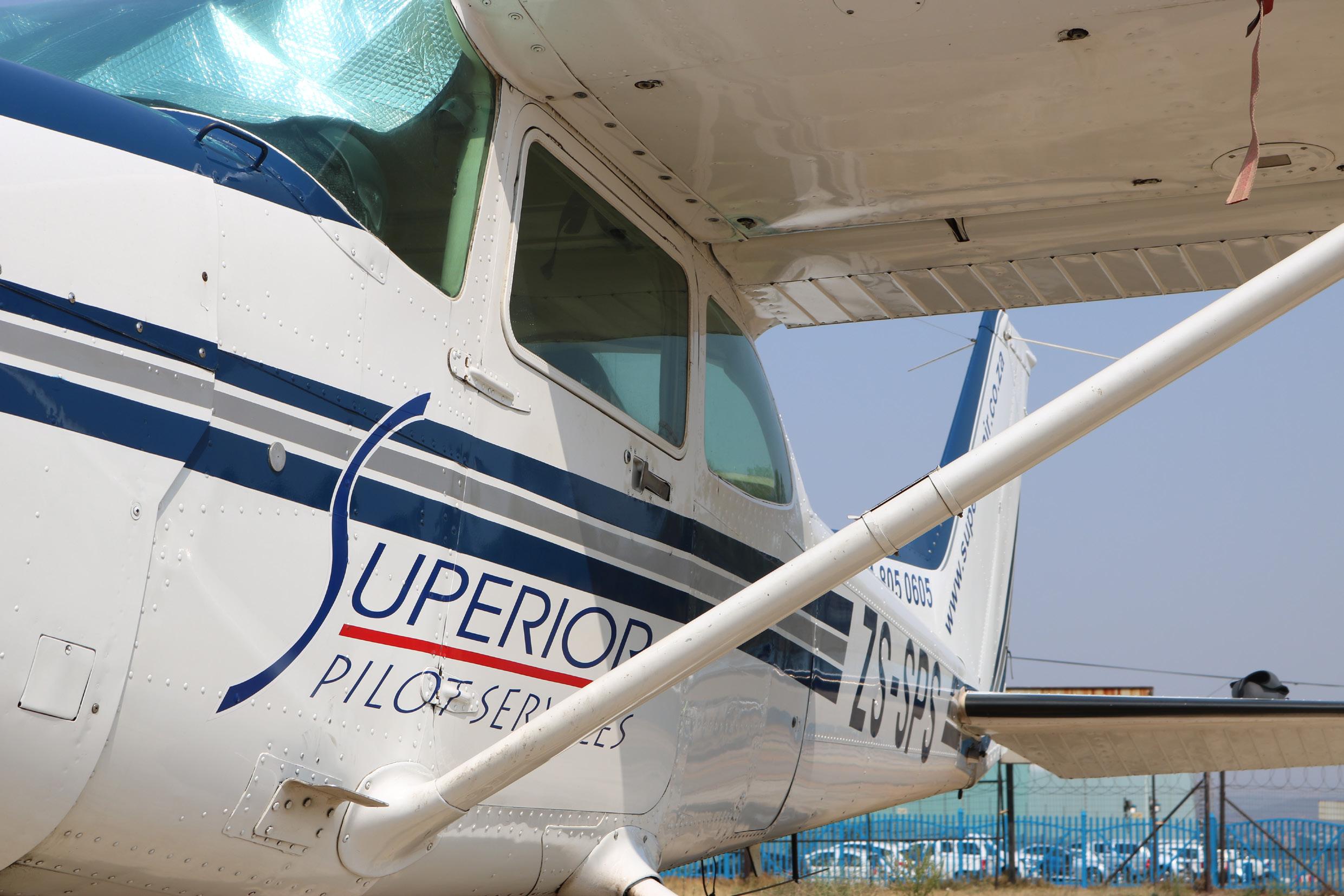




















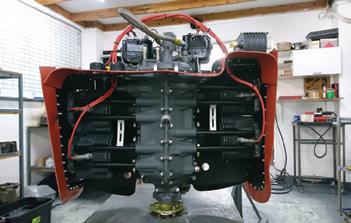



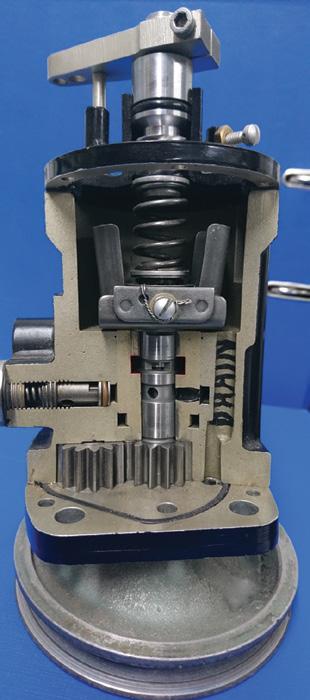

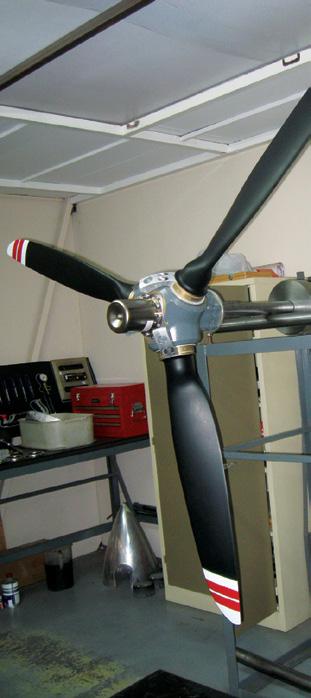







208 Aviation Ben Esterhuizen +27 83 744 3412 ben@208aviation.co.za www.208aviation.com
A1A Flight Examiner (Loutzavia)
Jannie Loutzis 012 567 6775 / 082 416 4069 jannie@loutzavia.co.za www.loutzavia.co.za
AES (Cape Town)
Erwin Erasmus 082 494 3722 erwin@aeroelectrical.co.za www.aeroelectrical.co.za
AES (Johannesburg)
Danie van Wyk 011 701 3200 office@aeroelectrical.co.za www.aeroelectrical.co.za
Aerocolour cc
Alfred Maraun 082 775 9720 aeroeng@iafrica.com
Aero Engineering & PowerPlant
Andre Labuschagne 012 543 0948 aerocolour@telkomsa.net
Aerokits
Jean Crous 072 6716 240 aerokits99@gmail.com
Aeronav Academy Donald O’Connor 011 701 3862 info@aeronav.co.za www.aeronav.co.za
Aeronautical Aviation
Clinton Carroll 011 659 1033 / 083 459 6279 clinton@aeronautical.co.za www.aeronautical.co.za
Aerospace Electroplating
Oliver Trollope 011 827 7535 petasus@mweb.co.za
Aerotel Martin den Dunnen 087 6556 737 reservations@aerotel.co.za www.aerotel.co.za
Aerotric
Richard Small 083 488 4535 aerotric@aol.com
Aviation Rebuilders cc
Lyn Jones 011 827 2491 / 082 872 4117 lyn@aviationrebuilders.com www.aviationrebuilders.com
AVIC International Flight Academy (AIFA)
Theo Erasmus 082 776 8883 rassie@aifa.co.za
Air 2000 (Pty) Ltd
Anne Gaines-Burrill 011 659 2449 - AH 082 770 2480 Fax 086 460 5501 air2000@global.co.za www.hunterssupport.com
Aircraft Finance Corporation & Leasing
Jaco Pietersen +27 [0]82 672 2262 jaco@airfincorp.co.za
Jason Seymour +27 [0]82 326 0147 jason@airfincorp.co.za www.airfincorp.co.za
Aircraft General Spares
Eric or Hayley 084 587 6414 or 067 154 2147 eric@acgs.co.za or hayley@acgs.co.za www.acgs.co.za
Aircraft Maintenance International
Pine Pienaar 083 305 0605 gm@aminternational.co.za
Aircraft Maintenance International Wonderboom Thomas Nel 082 444 7996 admin@aminternational.co.za
Air Line Pilots’ Association
Sonia Ferreira 011 394 5310 alpagm@iafrica.com www.alpa.co.za
Airshift Aircraft Sales
Eugene du Plessis 082 800 3094 eugene@airshift.co.za www.airshift.co.za
Alclad Sheetmetal Services
Ed Knibbs 083 251 4601 ed@alclad.co.za www.alclad.co.za
Algoa Flying Club
Sharon Mugridge 041 581 3274 info@algoafc.co.za www.algoafc.co.za
Alpi Aviation SA Dale De Klerk 082 556 3592 dale@alpiaviation.co.za www.alpiaviation.co.za
Apco (Ptyd) Ltd Tony/Henk + 27 12 543 0775 apcosupport@mweb.co.za www.apcosa.co.za
Ardent Aviation Consultants
Yolanda Vermeulen 082 784 0510 yolanda@ardentaviation.co.za www.ardentaviation.co.za
Ascend Aviation Marlo Kruyswijk 079 511 0080 marlo@ascendaviation.co.za www.ascendaviation.co.za
Atlas Aviation Lubricants
Steve Cloete 011 917 4220 Fax: 011 917 2100 sales.aviation@atlasoil.co.za www.atlasaviation.co.za
AVDEX (Pty) Ltd
Tania Botes 011 954 15364 info@avdex.co.za www.avdex.co.za
Aviatech Flight Academy Nico Smith 082 303 1124 viatechfakr@gmail.com www.aviatech.co.za
Aviation Direct Andrea Antel 011 465 2669 info@aviationdirect.co.za www.aviationdirect.co.za
Avtech
Riekert Stroh 082 749 9256 avtech1208@gmail.com
BAC Aviation AMO 115
Micky Joss 035 797 3610 monicad@bacmaintenance.co.za
Blackhawk Africa Cisca de Lange 083 514 8532 cisca@blackhawk.aero www.blackhawk.aero
Blue Chip Flight School Henk Kraaij 012 543 3050 bluechip@bluechip-avia.co.za www.bluechipflightschool.co.za
Border Aviation Club & Flight School
Liz Gous 043 736 6181 admin@borderaviation.co.za www.borderaviation.co.za
Bona Bona Game Lodge
MJ Ernst 082 075 3541 mj@bonabona.co.za www.bonabona.co.za
Breytech Aviation cc 012 567 3139 Willie Breytenbach admin@breytech.co.za
Celeste Sani Pak & Inflight Products Steve Harris 011 452 2456 admin@chemline.co.za www.chemline.co.za
Cape Town Flying Club
Beverley Combrink 021 934 0257 / 082 821 9013 info@capetownflyingclub.co.za www.@capetownflyingclub.co.za
Century Avionics cc Carin van Zyl 011 701 3244 sales@centuryavionics.co.za www.centuryavionics.co.za
Chemetall
Wayne Claassens 011 914 2500 wayne.claassens@basf.com www.chemetall.com
Chem-Line Aviation & Celeste Products
Steve Harris 011 452 2456 sales@chemline.co.za www.chemline.co.za
Clifton Electronics cc CJ Clifton / Irene Clifton 079 568 7205 / 082 926 8482 clive.iclifton@gmail.com
Comair Flight Services (Pty) Ltd Reception +27 11 540 7640/FAX: +27 11 252 9334 hello@flycfs.com www.flycfs.com
Corporate-Aviators/Affordable Jet Sales
Mike Helm 082 442 6239 corporate-aviators@iafrica.com www.corporate-aviators.com
CSA Aviation – Cirrus South Africa Alex Smith 011 701 3835 alexs@cirrussa.co.za www.cirrussa.co.za
C. W. Price & Co Kelvin L. Price 011 805 4720 cwp@cwprice.co.za www.cwprice.co.za
Dart Aeronautical Pieter Viljoen 011 827 8204 pieterviljoen@dartaero.co.za www.dartaero.co.za
Dart Aircraft Electrical Mathew Joubert 011 827 0371 Dartaircraftelectrical@gmail.com www.dartaero.co.za
Diepkloof Aircraft Maintenance cc Nick Kleinhans 083 454 6366 diepkloofamo@gmail.com
DJA Aviation Insurance 011 463 5550 0800Flying mail@dja-aviation.co.za www.dja-aviation.co.za
Dynamic Propellers
Andries Visser 011 824 5057 082 445 4496 andries@dynamicpropeller.co.za www.dynamicpropellers.co.za
Eagle Flight Academy Mr D. J. Lubbe 082 557 6429 training@eagleflight.co.za www.eagleflight.co.za
Execujet Africa 011 516 2300 enquiries@execujet.co.za www.execujet.com
Federal Air Rachel Muir 011 395 9000 shuttle@fedair.com www.fedair.com
Ferry Flights int.inc. Michael (Mick) Schittenhelm 082 442 6239 ferryflights@ferry-flights.com www.ferry-flights.com
F Gomes Upholsters
Carla de Lima 083 602 5658 delimaCarla92@gmail.com
Fireblade Aviation 010 595 3920 info@firebladeaviation.com www.firebladeaviation.com
Flight Training College Cornell Morton 044 876 9055 ftc@flighttrainning.co.za www.flighttraining.co.za
Flight Training Services Amanda Pearce 011 805 9015/6 amanda@fts.co.za www.fts.co.za
Fly Jetstream Aviation Henk Kraaij 083 279 7853 charter@flyjetstream.co.za www.flyjetstream.co.za
Flying Unlimited Flight School (Pty) Ltd Riaan Struwig 082 653 7504 / 086 770 8376 riaan@ppg.co.za www.ppg.co.za
Flyonics (Pty) Ltd Michael Karaolis 010 109 9405 michael@flyonics.co.za www.flyonics.co.za
Gemair
Andries Venter 011 701 2653 / 082 905 5760 andries@gemair.co.za
GIB Aviation Insurance Brokers Richard Turner 011 483 1212 aviation@gib.co.za www.gib.co.za
Guardian Air 011 701 3011 082 521 2394 ops@guardianair.co.za www.guardianair.co.za
Heli-Afrique cc Tino Conceicao 083 458 2172 tino.conceicao@heli-afrique.co.za
Henley Air Andre Coetzee 011 827 5503 andre@henleyair.co.za www.henleyair.co.za
Hover Dynamics Phillip Cope 074 231 2964 info@hover.co.za www.hover.co.za
Indigo Helicopters Gerhard Kleynhans 082 927 4031 / 086 528 4234 veroeschka@indigohelicopters.co.za www.indigohelicopters.co.za
IndigoSat South Africa - Aircraft Tracking Gareth Willers 08600 22 121 sales@indigosat.co.za www.indigosat.co.za
International Flight Clearances Steve Wright 076 983 1089 (24 Hrs) flightops@flyifc.co.za www.flyifc.co.za
Investment Aircraft
Quinton Warne 082 806 5193 aviation@lantic.net www.investmentaircraft.com
Jabiru Aircraft
Len Alford 044 876 9991 / 044 876 9993 info@jabiru.co.za www.jabiru.co.za
Jim Davis Books
Jim Davis 072 188 6484 jim@border.co.za www.jimdavis.co.za
Joc Air T/A The Propeller Shop
Aiden O’Mahony 011 701 3114 jocprop@iafrica.com
Johannesburg Flying Academy
Alan Stewart 083 702 3680 info@jhbflying.co.za www.jhbflying.co.za
Kishugu Aviation +27 13 741 6400 comms@kishugu.com www.kishugu.com/kishugu-aviation
Khubenker Energy (Pty) Ltd T/A Benveroy
Vernon Bartlett 086 484 4296 vernon@khubenker.co.za www.khubenker.co.za
Kit Planes for Africa
Stefan Coetzee 013 793 7013 info@saplanes.co.za www.saplanes.co.za
Kzn Aviation (Pty) Ltd
Melanie Jordaan 031 564 6215 mel@kznaviation.co.za www.kznaviation.co.za
Lanseria Aircraft Interiors
Francois Denton 011 659 1962 / 076 810 9751 francois@aircraftcompletions.co.za
Lanseria Flight Centre
Ian Dyson
Tel: +27 11 312 5166, F: +27 11 312 5166 ian@flylfc.com www.flylfc.com
Lanseria International Airport
Mike Christoph 011 367 0300 mikec@lanseria.co.za www.lanseria.co.za
Leading Edge Aviation cc
Peter Jackson Tel 013 741 3654 Fax 013 741 1303 office@leaviation.co.za www.leadingedgeaviation.co.za
Legend Sky 083 860 5225 / 086 600 7285 info@legendssky.co.za www.legendsky.co.za
Litson & Associates (Pty) Ltd
OGP/BARS Auditing & Advisory Services & Aviation Safety Training
Email: Phone:enquiries@litson.co.za 27 (0) 8517187 www.litson.co.za
Litson & Associates Risk Management
Services (Pty) Ltd
eSMS-S™/ eTENDER/ e-REPORT / Aviation Software Systems
Email: Phone:enquiries@litson.co.za 27 (0) 8517187 www.litson.co.za
Loutzavia Aircraft Sales
Henry Miles 082 966 0911 henry@loutzavia.co.za www.loutzavia.co.za
Loutzavia Flight Training
Gerhardt Botha 012 567 6775 ops@loutzavia.co.za www.loutzavia.co.za
Loutzavia-Pilots and Planes
Maria Loutzis 012 567 6775 maria@loutzavia.co.za www.pilotsnplanes.co.za
Loutzavia Rand Frans Pretorius 011 824 3804 rand@loutzavia.co.za www@loutzavia.co.za
Lowveld Aero Club
Pugs Steyn 013 741 3636 Flynow@lac.co.za
Maverick Air Charters
Lourens Human 082 570 2743 ops@maverickair.co.za www.maverickair.co.za
MCC Aviation Pty Ltd
Claude Oberholzer 011 701 2332 info@flymcc.co.za www.flymcc.co.za
Mistral Aviation Services
Peter de Beer 083 208 7249 peter@mistral.co.za
MH Aviation Services (Pty) Ltd
Marc Pienaar 011 609 0123 / 082 940 5437 customerrelations@mhaviation.co.za www.mhaviation.co.za
M and N Acoustic Services cc Martin de Beer 012 689 2007/8 calservice@mweb.co.za
Metropolitan Aviation (Pty) Ltd
Gert Mouton 082 458 3736 herenbus@gmail.com
Money Aviation Angus Money 083 263 2934 angus@moneyaviation.co.za www.moneyaviation.co.za
Mont Blanc Financial Services Devon Ford devon@mbfs.co.za www.mbfs.co.za
North East Avionics
Keith Robertson +27 13 741 2986 keith@northeastavionics.co.za deborah@northeastavionics.co.za www.northeastavionics.co.za
Orsmond Aviation 058 303 5261 info@orsmondaviation.co.za www.orsmondaviation.co.za
Owenair (Pty) Ltd
Clive Skinner 082 923 9580 clive.skinner@owenair.co.za www.owenwair.co.za
Par-Avion Exclusive Catering
Jakkie Vorster 011 701 2600 accounts@par-avion.co.za www.par-avion.co.za
PFERD-South Africa (Pty) Ltd
Hannes Nortman 011 230 4000 hannes.nortman@pferd.co.za www.pferd.com
Plane Maintenance Facility
Johan 083 300 3619 pmf@myconnection.co.za
Powered Flight Charters
Johanita Jacobs
Tel 012 007 0244/Fax 0866 66 2077 info@poweredflight.co.za www.poweredflight.co.za
Powered Flight Training Centre
Johanita Jacobs Tel 012 007 0244/Fax 0866 66 2077 info@poweredflight.co.za www.poweredflight.co.za
Precision Aviation Services
Marnix Hulleman 012 543 0371 marnix@pasaviation.co.za www.pasaviation.co.za
Propeller Centre
Theuns du Toit +27 12 567 1689 / +27 71 362 5152 theuns@propcentre.co.za www.propcentre.com
Rainbow SkyReach (Pty) Ltd
Mike Gill 011 817 2298 Mike@fly-skyreach.com www.fly-skyreach.com
Rand Airport
Kevin van Zyl Kevin@horizonrisk.co.za +27 76 801 5639 www.randairport.co.za
Dr Rudi Britz Aviation Medical Clinic
Megan 066 177 7194 rudiavmed@gmail.com Wonderboom Airport
SAA Technical (SOC) Ltd
SAAT Marketing 011 978 9993 satmarketing@flysaa.com www.flysaa.com/technical
SABRE Aircraft Richard Stubbs 083 655 0355 richardstubbs@mweb.co.za www.aircraftafrica.co.za
Savannah Helicopters
De 082Jager 444 1138 / 044 873 3288 dejager@savannahhelicopters.co.za www.savannahhelicopters.co.za
Scenic Air
Christa van Wyk +264 612 492 68 windhoek@scenic-air.com www.scenic-air.com
Sheltam Aviation Durban Susan Ryan 083 505 4882 susanryan@sheltam.com www.sheltamaviation.com
Sheltam Aviation PE Brendan Booker 082 497 6565 brendanb@sheltam.com www.sheltamaviation.com
Signature Flight Support Cape Town Alan Olivier 021 934 0350 cpt@signatureflight.co.za www.signatureaviation.com/locations/CPT
Signco (Pty Ltd) Archie Kemp Tel 011 452 6857 Fax 086 504 5239 info@signco.zo.za www.signco.co.za
Skytrim
Rico Kruger +27 11 827 6638 rico@skytrim.co.za www.skytrim.co.za
SleepOver Michael Richardson 010 110 9900 michael.richardson@sleepover-za.com www.sleepover-za.com
Sling Aircraft Kim Bell-Cross 011 948 9898 sales@airplanefactory.co.za www.airplanefactory.co.za
Solenta Aviation (Pty Ltd) Paul Hurst 011 707 4000 info@solenta.com www.solenta.com
Southern Energy Company (Pty) Ltd Elke Bertram +264 8114 29958 johnnym@sec.com.na www.sec.com.na
Southern Rotorcraft cc Mr Reg Denysschen Tel no: 0219350980 sasales@rotors-r-us.com www.rotors-r-us.com
Starlite Aero Sales
Klara Fouché +27 83 324 8530 / +27 31 571 6600 klaraf@starliteaviation.com www.starliteaviation.com
Starlite Aviation Operations
Trisha Andhee +27 82 660 3018/ +27 31 571 6600 trishaa@starliteaviation.com www.starliteaviation.com
Starlite Aviation Training Academy Durban: +27 31 571 6600 Mossel Bay: +27 44 692 0006 train@starliteaviation.com www.starliteaviation.com
Status Aviation (Pty) Ltd
Richard Donian 074 587 5978 / 086 673 5266 info@statusaviation.co.za www.statusaviation.co.za
Superior Pilot Services Liana Jansen van 0118050605/2247Rensburg info@superiorair.co.za www.superiorair.co.za
Swift Flite
Linda Naidoo
Tel 011 701 3298 Fax 011 701 3297 info@swiftflite.com / linda@swiftflite.com www.swiftflite.co.za
The Aviation Shop Karel Zaayman 010 020 1618 info@aviationshop.co.za www.aviationshop.co.za
The Copter Shop Bill Olmsted 082 454 8555 execheli@iafrica.com www.execheli.wixsite.com/the-copter-shop-sa
The Pilot Shop
Helen Bosland 082 556 3729 helen@pilotshop.co.za www.pilotshop.co.za
Titan Helicopter Group 044 878 0453 info@titanhelicopters.com www.titanhelicopters.com
Top Flight Academy Nico Smith 082 303 1124 topflightklerksdorp@gmail.com
Turbo Prop Service Centre 011 701 3210 info@tpscsa.co.za www.tpscsa.co.za
Ultimax Aviation (Pty) Ltd Aristide Loumouamou +27 72 878 8786 aristide@ultimax-aviation.com www.ultimax-aviation.com
United Charter cc Jonathan Wolpe 083 270 8886 jonathan.wolpe@unitedcharter.co.za www.unitedcharter.co.za
United Flight Support Clinton Moodley/Jonathan Wolpe 076 813 7754 / 011 788 0813 ops@unitedflightsupported.com www.unitedflightsupport.com
Velocity Aviation Collin Pearson 011 659 2306 / 011 659 2334 collin@velocityaviation.co.za www.velocityaviation.co.za
Villa San Giovanni Luca Maiorana 012 111 8888 info@vsg.co.za www.vsg.co.za
Vortx Aviation Bredell Roux 072 480 0359 info@vortx.co.za www.vortxaviation.com
Wanafly
Adrian Barry 082 493 9101 adrian@wanafly.net www.wanafly.co.za
Windhoek Flight Training Centre
Thinus Dreyer 0026 40 811284 180 pilots@flywftc.com www.flywftc.com
Wings n Things
Colin Blanchard 011 701 3209 wendy@wingsnthings.co.za www.wingsnthings.co.za
Witbank Flight School
Andre De Villiers 083 604 1718 andredv@lantic.net www.waaflyingclub.co.za
Wonderboom Airport
Peet van Rensburg 012 567 1188/9 peet@wonderboomairport.co.za www.wonderboomairport.co.za
Zandspruit Bush & Aero Estate
Martin Den Dunnen 082 449 8895 martin@zandspruit.co.za www.zandspruit.co.za
Zebula Golf Estate & SPA Reservations 014 734 7700 reception@zebula.co.za www.zebula.co.za